UNSUSTAINABLE SITUATION
FM’s role in carbon reduction planning is being disregarded

RETROFIT FOR PURPOSE
A UK Net Zero Carbon Buildings Standard could boost retrofits

FLEXIBILITY AS FRIEND
Occupier uncertainty is emphasising flexible design

DISRUPTIVE INFLUENCES

How the leaders of mid-market service providers are injecting fresh impetus into the wider outsourced FM service market

MARCH-APRIL 2024● FACILITATEMAGAZINE.COM IWFM SUSTAINABILITY SURVEY REPORT ● PSYCHOLOGICAL SAFETY IN THE WORKPLACE ● FM’S MID-MARKET GAME CHANGERS INFORMING WORKPLACE AND FACILITIES PROFESSIONALS MARCH-APRIL 2024


Hitting your






Helping you
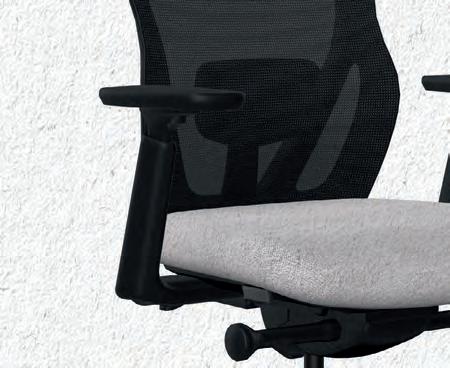





Meeting your Giving you


With 75 years of experience in supplying furniture projects to businesses across the UK, our end-to-end service provides DSE assessments, space planning and interior design as standard. And we don’t just offer furniture solutions: we deliver complex design & build schemes nationwide. Find out how we can create your next workplace scheme and


020 3649 8585 eastoncommercialinteriors.co.uk
This is so much more than a chair.
Offering Supporting a
FURNITURE | INTERIOR DESIGN | M&E | HVAC | DILAPIDATIONS AUDIO VISUAL | IT | D&B | CAT A&B FIT OUT
CONTENTS

06

49
26
FRONT DESK
06 Absenteeism is rife Long-term sickness is depleting an already sparse labour market
14


53

10 Humanising tech Tech and people were the key focus points at Workplace Futures
12 Flexibility is key for over-50s Recruiting and retaining workers over 50 is easier to do when flexibility is on offer
14 Policy updates
The hot topics IWFM is currently pursuing on behalf of members
17 News in Numbers
Numerical take on the big news from January and February FEATURES
18-25 Game changers
Meet the nimble SME service providers disrupting the outsourced FM service market
26-30 Vetting the assets
Using the UK Net Zero Carbon Buildings Standard to prove that your assets are net zero carbon
32-37 Flexibility’s your friend
The one controllable variable set to be common to the future office workplace
VIEW POINT
40 Perspectives
Four FM professionals seek to influence your insight agenda
44 A bit about you
Behind the jobs of John Cameron and Wendy Wallace

44
KNOW HOW
47 Tek screw timebomb Don’t use steel self-drilling screws to fix fire dampers
48 Brain food School caterers should teach kids healthy eating habits
49 Net zero confident FMs are integral to organisations’ decarbonisation goals
53 Foster psychological safety Leaders should create a safe space for their team members
55 Avoid these Friday fails Don’t be the kind of leader to burden employees just before their weekend begins
56 Use AI for your next bid Humans and AI can work together to improve the quality of bid writing to win tenders
SUPPLY SIDE
62 OCS plans to double its revenue in the next five years
The service provider will focus on “five pillars” to achieve its goals: delivering the best experiences, productivity, practices, resilience, and outcomes for all stakeholders

FACILITATEMAGAZINE.COM 3 MARCH-APRIL 2024 / FACILITATE
ONLINE
COMMENT
NHS backlogs require urgent action
The NHS estates maintenance backlog has soared to new heights and outdated buildings are causing more than 100 care disruptions every week in the UK, says Marc Watkins, business development director at Service Works Global.
tinyurl.com/Fac24029
Be safer with digital fire detection
Digital fire detection solutions can add an extra layer of interconnectivity to FMs, says Rik Firth, head of operations at Your Choice Fire & Security.
tinyurl.com/Fac24030
Imagine your ideal day in FM
The elusive ideal workday in FM is a bit like chasing a mythical creature (and why not? We do everything else), says Simone Fenton-Jarvis, group director of workplace consultancy and transformation at VPOD Smart Solutions.
tinyurl.com/Fac24031
EDI has proven its value
Equity, diversity and inclusion policies have already had a positive impact on clients and society, with diverse and inclusive organisations performing better than their peers, says Sharon Slinger, MD of Constructing Rainbows.
tinyurl.com/Fac24034
FACILITATE
REPORTS
Neurodivergent employees suffering at work
One in five neurodivergent employees has experienced harassment or discrimination at work, according to research by CIPD.
tinyurl.com/Fac24032
Security must not be a design afterthought
Despite increased commitment to ‘security-by-design’ principles, the industry is spending time and money postbuild to fix security issues.
tinyurl.com/Fac24033
Working from home is good for your health
Working from home allows people to eat more healthily and feel less stressed, according to the latest research.
tinyurl.com/Fac24035
WFMs need involvement in early sustainability plans
Only 13% of workplace and facilities managers led on sustainability plans, according to IWFM’s Sustainability Survey. tinyurl.com/Fac24036
YOUR AWARD-WINNING MAGAZINE
at the Association Excellence Awards, the body which assesses the media brands of trade bodies, membership organisations and associations. In 2023,
and IWFM were judged to have conducted the best association digital transformation at the same awards, the work
described as ‘a stellar example of how a digital transition driven by deep understanding of the audience’s needs can future fit a professional body’s content strategy. At the same time opening commercial opportunities for new revenue streams’ Got a story?
email editorial @ facilitatemagazine.com
Facilitate, incorporating FM World, is the publication of IWFM, the professional body for workplace and facilities management. For information on membership, qualifications and training contact us:
Institute of Workplace and Facilities Management
Suite 15, Thremhall Park, Start Hill, Bishop’s Stortford, Hertfordshire, CM22 7WE, UK
+44 (0)1279 712 620 • admin@iwfm.org.uk • www.iwfm.org.uk
Redactive Publishing Ltd Fora, 9 Dallington Street London EC1V 0LN www.facilitatemagazine.com
EDITOR Martin Read 020 7880 7664 martin.read@facilitatemagazine.com
DEPUTY EDITOR Bradford Keen 020 7880 7615 bradford.keen@facilitatemagazine.com
NEWS EDITOR Herpreet Kaur Grewal 020 7880 8544 newsdesk@facilitatemagazine.com
SUB-EDITOR Deborah Shrewsbury 020 7880 6223 deborah.shrewsbury@redactive.co.uk
SENIOR DESIGNER Joe McAllister 020 7880 2747 joe.mcallister@redactive.co.uk
PICTURE EDITOR Claire Echavarry 020 7324 2701 claire.echavarry@redactive.co.uk
CONTENT ASSISTANT Prithvi Pandya 020 7880 6229 prithvi.pandya@redactive.co.uk
SALES — DISPLAY, DIGITAL, EVENTS
020 7880 6206 display@facilitatemagazine.com
SALES — RECRUITMENT
020 7880 6212 recruitment@facilitatemagazine.com
PRODUCTION MANAGER Aysha Miah-Edwards 020 7880 6241 aysha.miah@redactive.co.uk
PUBLISHING DIRECTOR Joanna Marsh
020 7880 8542 joanna.marsh@redactive.co.uk
Subscriptions IWFM members with Facilitate subscription or delivery queries should call the IWFM’s membership department on +44 (0)1279 712650.
Facilitate is sent to all members of the Institute of Workplace and Facilities Management and is available on subscription to non-members. Annual subscription rates are UK £110, Europe £120 and rest of world £130.
To subscribe call 01580 883844 or email subs@redactive. co.uk – alternatively, you can subscribe online at www.facilitatemagazine.com/about-us/subscribe/
Editorial Advisory Board
Simon Ball, market director, EQUANS UK & Ireland
Rob Greenfield, regional health & safety consultant, Croner Ian Jones, director of workplace services and estates, ITV Kate Smith, executive director, consulting, CBRE UK Liz Kentish, managing director, Kentish and Co. Simone Fenton-Jarvis, group director of workplace consultancy and transformation, VPOD Smart Solutions
Printed by Warners
Average net circulation
10,977 (July 2022 to June 2023)
Facilitate (Print) ISSN 2752-5171
Recycle your magazine’s plastic wrap – check your local LDPE facilities to find out how.

and
news
resource
the Institute of
(IWFM). We inform members and others about the latest thinking around workplace and facilities management.
we were judged Best
32,000
Facilitate is the magazine
online
content
of
Workplace and Facilities Management
In 2019,
Magazine (10-
members)
Facilitate
FACILITATE / ONLINE 4 FACILITATE MARCH-APRIL 2024
COMMENTS

UPSKILL AND RESKILL –IT’S AN URGENT PRIORITY
There is an infamous, poorly tackled trend in workplace and facilities management (WFM) and the UK economy: the skills shortage. A long-term blight across sectors, it hampers productivity, competitiveness and economic growth. While upskilling and reskilling are key organisational concerns, it’s important to put policy into practice to drive change in 2024.
Underinvestment is a key issue. In the neverending jostle of budget allocation, employees’ skills and knowledge have been neglected, affecting everything from recruitment and retention to organisational performance. Upskilling and reskilling can attract staff, but daily workloads often sideline these initiatives.
As workplaces become more complex and digitally advanced, demand for skilled professionals increases but the resources haven’t been allocated to develop staff – affecting those who may not realise how innovative WFM now is.
However, at IWFM, we’ve identified solutions. Organisations can invest in cost-effective development of their employees and offer attractive career opportunities in the sector. Additionally, they can collaborate with groups like IWFM to promote the profession and raise awareness about its lynchpin role.
Upskilling and reskilling can be embedded into daily work, such as learning to implement and manage digital systems to regulate buildings and save costs. Organisations that take these steps can boost staff retention and be an appealing partner to organisations across the sector.
With high demand on WFM in 2024, it’s time to align people with profits to build both.
 LINDA HAUSMANIS is CEO of the IWFM
LINDA HAUSMANIS is CEO of the IWFM
MARTIN READ
From the editor
Given that the longterm impact of the smartphone is still to be fully documented – that ubiquitous device still evolving our ideas of what instant internet access can do for us – it may seem a bit early to be unnerved at Apple’s latest exercise in popularising an emerging technology.
Nevertheless, the company’s entry into the augmented reality space, with its absurdly priced headset, has had me thinking. In the weeks after release, one enterprising individual had mapped out a floor space with bright yellow digital markers; pass over it with your vacuum cleaner and those yellow markers disappear (thus ending the very notion of ‘you’ve missed a bit’). Another bright spark showed off a three dimensional miniaturised motor racing circuit in his front room that allowed you to walk the circuit and view a race from any angle; a startlingly comprehensive digital twin.
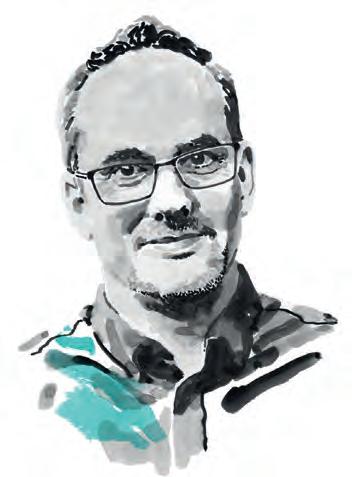
Will we all soon have these things strapped around our eyes, pecking about at the thin air in front of us? I might once have said ‘of course not you babbling lunatic’. But these days, who can really say? Witness facilities service provider Churchill using VR headsets to train operatives on the specific requirements of a cleaning contract, to much praise from users and industry observers alike. Perhaps we’re just a year or two from cleaners wearing VR headsets as they actually go about their work, contract requirements programmed directly into their eyes.
Will we all have these things strapped around our eyes, pecking about at thin air?
Well, we’ll see. But in any event the many interfaces between people and technology will only become of increasing importance from a workplace skills development perspective. We’re told that, in many cases, the skills that our job roles require today will be next to useless in a decade’s time. For organisations, the requirement is no longer simply to support the acquisition of skills, but
also to create and nurture a skills development ecosystem, employing people sufficiently equipped to assess the skills shortfalls in others and who can assign bespoke training methods to varying trainee personas. The human requirement of FM service in our tech-enabled age demands a fresh approach to training.

MARTIN READ is the editor of Facilitate magazine
LINDA HAUSMANIS
COMMENTS / LEADER FACILITATEMAGAZINE.COM 5 ILLUSTRATIONS: SAM KERR
08
FRONT DESK
IWFM Sustainability Report: FMs must be more involved in green investment decisions
D10
The uncertainty and opportunity in FM’s approach to people and technology
ata published in February indicated a record number of potential workers inactive through long-term sickness, an issue compounding already concerning labour supply issues. No fewer than 2.8 million people are out of the market because of long-term illness.
It’s a startling statistic. The Office for National Statistics (ONS) labour market figures also showed that average earnings rose by 6.2%, (unexpected) and that wages rose at a slower pace than the 6.5% increase predicted in the three months up to November last year. Also, more than a million people are on zero-hours contracts.
Jon Boys, senior labour market economist for CIPD, the professional body for HR and people development, said while “we shouldn’t read too much into small movements” he thinks “wages aren’t growing as fast as in previous months. Unemployment remains low, particularly in relation to historical norms”.
However, Boys expressed concern about that 2.8 million figure. “With historically high numbers of people inactive due to long-term sickness, businesses are struggling to secure candidates even while vacancies continue to fall. Addressing the UK’s ill health must be a key priority for the government.”
Absences or inactivity due to ill health “is higher than previously estimated”, says Boys. “The reduction in workers is compounding labour supply difficulties and limiting UK growth. Breaking down barriers to working for people with health conditions must be a priority for policymakers and employers. It’s imperative to prioritise
The reduction in workers is compounding labour supply difficulties
12
Over-50s now make up more than 30% of those in work –and they want flexible working
Absenteeism and sickness ‘driving labour out of workforce’
by Herpreet Kaur Grewal
17
News in Numbers: key stories boiled down into numerical form
 WORKER WELLBEING
WORKER WELLBEING
6 FACILITATE MARCH-APRIL 2024
CRITICAL ANALYSIS
EMERGING THEMES AND TRENDS
OF
occupational health services to prevent individuals from exiting the workforce prematurely. Employers should be aware of the impact that stress in the workplace can have on people’s health and take steps to address this. This means careful attention to job design and addressing heavy and unsustainable workloads.”
Unexplained absences
Other commentators are ringing the alarm. The employment team at law firm Charles Russell Speechlys reported “a surge in the number of businesses seeking advice on what to do about unexplained staff absences” in the last couple of years, particularly in retail and hospitality.
Nick Hurley, partner and head of employment, said: “What we have noticed is in those sectors where perhaps
ACCESS TO HELP 1.8m
An estimated 1.8 million workers reported workrelated ill health in 2022/23
45%
Only 45% of workers in the UK have access to some form of occupational health
28%
Only 28% of employers in the UK provide some form of occupational health
3x
Large employers (89%) are nearly three times more likely to provide a form of occupational health than SMEs
28%
Only 28% of small and medium enterprises (SMEs) provide a form of occupational health
(SOURCE:
wages and skills are a little lower, there is a definite increase in the number of employees who are just not showing up to work – and leaving the employer in the doo-doo, as it were.”
Such unexplained absences are often, said Hurley, a result of mental health issues, which have become more prevalent, particularly among young people, since the pandemic.
Vicky Walker, group director of people at Westfield Health and an HR expert, said: “People’s access to mental health… highlight[s] a systemic issue that needs tackling. But it’s equally important that we drive positive change through healthier workplace wellbeing solutions. While having clauses in contracts for reviews with occupational therapists may seem proactive, the reality of NHS backlogs makes this avenue impractical and it’s crucial to question if this approach meets people’s diverse needs.”
Government response
As a result of these alarming trends, the government has set up a new task force, headed by Dame Carol Black as the new occupational health tsar, to urge businesses to tackle in-work sickness and stop people from falling out of the workforce.
Dame Carol, with decades of experience in medicine, policy advisory and chairing multiple government reviews, will lead the task force to produce a voluntary occupational health framework for businesses, which will include minimum levels of occupational health needed to stop sickness-related job losses and help businesses to support those returning to work after a period of ill-health.
The government will use the framework – expected in summer – to reduce inactivity levels and waiting list times.
Jo Churchill, minister for employment, said: “Millions of working days are lost each year through sickness. We are helping businesses tackle this challenge head-on so we can help boost productivity and grow our economy. The work of Dame Carol and her expert task force will be crucial as we drive down absenteeism, which we know is holding back British businesses and really focus on making occupational health support available to all.
STAY-IN-WORK SUPPORT
OCCUPATIONAL HEALTH
The task force comes as the government gets a £64 million pilot of a new WorkWell service under way, which has been designed to help 60,000 people with health conditions stay and succeed in work through integrated employment and health support.
The task force’s first meeting planned how to increase access and uptake of occupational health through:
● Increasing information and visibility for employers on occupational health and the benefits of quality occupational health provision in retaining employees in the workplace;
● Empowering employers to play an active role in improving employee health;
● Removing barriers by focusing on SMEs with restricted finances and by ensuring the framework is applicable across sectors; and
● Complementing existing health and disability workplace initiatives, including where occupational health is required in law.
“Our £2.5 billion Back to Work Plan will also help one million people, including those with long-term health conditions and disabilities, find work and reap the benefits it has to offer.”
Dame Carol said: “We know the impact high sickness absence and presenteeism has on businesses and their productivity, which is why I am so pleased to work with other members of the task force to ensure occupational health support is in place for employees and employers alike.”
The UK Government’s Occupational Health Innovation Fund has given £1 million to 10 projects to develop innovative new models of occupational health, using technology to improve the capacity and capability of providers and increase access for SMEs.
ILL HEALTH
FACILITATEMAGAZINE.COM 7 ANALYSIS / FRONT DESK IMAGE: ISTOCK
DEPARTMENT FOR WORK AND PENSIONS)
Sustainability: More FM involvement required, and more investment needed
by Herpreet Kaur Grewal and Martin Read

Published in February, IWFM’s annual sustainability survey report honed its focus on two key aspects of FM’s interaction with sustainability initiatives, each identifiable in a statistic. The first is that only 13% of workplace and facilities managers (WFMs) led in the development of their organisation’s sustainability plans, where they are in place or being developed. The second is that just one in three WFMs were ordinary stakeholders “at best” when drawing up energy efficiency and carbon reduction plans.
The Sustainability Survey 2023 report, in-field between August and September 2023, received 620 responses – a healthy figure for this annual exercise, which has now spanned three decades.
For IWFM CEO Linda Hausmanis, the results were both frustrating for what they say about current levels of organisational trust in the FM function – and, at the same time, a golden opportunity to do something about it.
“We call on all WFMs to put their value into action and take up the opportunity to create and drive forward organisational transition plans,” she said. “As the research uncovers the lack of ownership for net zero delivery within organisations, it clearly shows a gaping opportunity for our profession.
“To business we say, don’t take forward any plans without putting your WFMs central to them. You want to see a clear return on investment, after all.”
Project investment
Indeed, investment in projects to mitigate climate change needed “a complete overhaul”, Hausmanis said.
“Organisational funding should be flooding into new equipment and workplace improvements that would make life better for people and the planet and profit,” she exclaimed. “It isn’t.
“This is important because we’re starting to see that not dealing with
“Scope 3 is going to appear like the shark from Jaws out of the water and bite people’s legs off”
IWFM SUSTAINABILITY REPORT
FRONT DESK / ANALYSIS 8 FACILITATE MARCH-APRIL 2024
climate risk is negatively impacting the value of assets, with many of them overvalued. The lack of climate investments will therefore become increasingly a financial risk for WFMs to manage too. This is another reason why WFMs should be leading holistic transition plans.”
Sofie Hooper, head of policy and research at IWFM, said: “Every way you look at it, WFMs must be a key stakeholder when drawing up energy and carbon plans. They directly manage the buildings that account for much of the energy and carbon emissions, they understand the art of the possible in terms of change, and are best placed to influence the outcomes. Plans without WFMs are flawed from the get-go.”
Is overconfidence a factor?
One of the ways that some WFMs hinder themselves, according to the report, is through an overconfidence about their readiness to address the challenges of energy and carbon reduction. This, the report’s authors assert, “is an invisible enemy to progress”.
As many as 72% of those surveyed who had plans in place said that they fully understand how to address emissions and have programmes to achieve all their goals.
These FMs with energy efficiency and carbon reduction plans in place
“Organisational funding should be flooding into new equipment and workplace improvements that would make life better for people and the planet and profit! It isn’t”
“don’t see many weaknesses in them”, according to the report. But just 5% of respondents selected the option ‘it doesn’t cover any of Scope 3’ when identifying possible weaknesses in their plans.
There are three reasons for this overconfidence, the report’s authors claim. Firstly, organisations are relying “too much on the decarbonisation of the grid and Renewable Energy Guarantees of Origin (REGO) certificates” to meet their net zero ambitions rather than developing programmes that really drive carbon reduction.
“What they fail to realise too is that their REGO certificates may not count towards net zero in the long term,” the authors note.
Secondly, when the same question about weaknesses in client plans was put to FM service providers the number of weaknesses they identified shot up. “FM service providers are looking at this very differently to” WFMs, the report states.
Finally, there is perhaps some overconfidence implicit in FMs’ turning “a blind eye” to Scope 3 emissions to focus solely on those in Scopes 1 and 2.
Reid Cunningham, sustainability SIG member and business development director at BAM FM and BAM Energy, said: “ Scope 3 is going to appear like the shark from Jaws out of the water and bite people’s legs off. It’s going to give everyone the fright of their lives when they realise that sciencebased targets include Scope 3 – and they’ve all committed to net zero in five years.”
Science-based targets
Larger firms are seeing “the shark fin of Scope 3 approaching through the water”, the report adds.Asked about weaknesses in their plans, WFMs in larger companies listed ‘it doesn’t cover all of Scope 3’ as one of their top four answers – much higher than respondents from other companies.
Hooper argued: “This may be because mandatory Scope 3 reporting is a live issue on their risk registers. The government consultation is a clear indication that this may become mandatory sooner rather than later.”
5% – 20%
The potential saving in energy use just from having better understanding of energy data
65%
Percentage of client-side FMs believing that management of the whole life of a building (not just immediate services) is where they can add the most value in energy efficiency/ decarbonisation/net zero plans
27%
Those same client-side FMs saying that ‘championing the importance of scope 3 emissions’ is where they can add value (IWFM’s Sustainability SIG believes this area of work is under-appreciated by FMs)
43%
Percentage of organisations expecting individually assessed projects to meet or exceed normal ROI criteria
22%
Percentage of investments relating to energy efficiency/ decarbonisation/net zero funded through allocated budget
18%
Respondents unable to explain their organisation’s criteria for investment return requirements for projects relating to energy efficiency/ decarbonisation/net zero
IWFM SUSTAINABILITY SURVEY RESULTS ENERGY-EFFICIENT
ATTITUDES
Download the IWFM Sustainability Report: ANALYSIS / FRONT DESK FACILITATEMAGAZINE.COM 9 IMAGE: ISTOCK
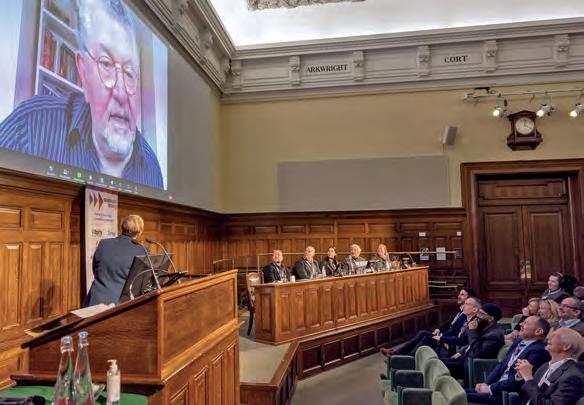
At this stage of the 2020s, any talk about developments in facilities service delivery comes down to two primary components – people or technology. If we’re not talking about the one, we’re talking about the other, with all the many intersections between both to the fore. As concerns the people, there’s a palpable sense of this being a sector in experimentation mode, assessing the extent to which employees can be empowered at site level, or whether there exists sufficiently equitable representation in the ranks: and on technology – be it the robotics, artificial intelligence, or the potentially game-changing operator-level use of apps – there’s that first of many potential intersectional linkages. And it’s in to this picture that the 2024 Workplace Futures conference took place in February.
Across the traditionally busy day of presentations, we heard of the steady if fragile return to the office. And when those workers do in fact return, there is, said Katherine Harvey, global consultancy director of Unwork, a new layer of ‘day makers’ on hand to make the workplace they experience the one that they increasingly demand of it. Harvey spoke of the increasing use of distinct worker ‘personas’, with organisations differentiating
their workplaces accordingly - and the expectation of millennials downward being of every transaction being initiated through their smartphone interface.
Return on experience
“I keep hearing the word ‘joy’ a lot when I speak to clients,” she said. “How do you bring joy into the day?
Something that is more than the sums of its parts? The trend, said Harvey, is towards tech enabling people at a granular level, “and a trend we are seeing is one of a ‘return on experience’”.
Leanne Lynch, chief information officer at ISS spoke of how we all of us are increasingly coming to terms with being our own walking Internet of Things, will all the personal interconnection with
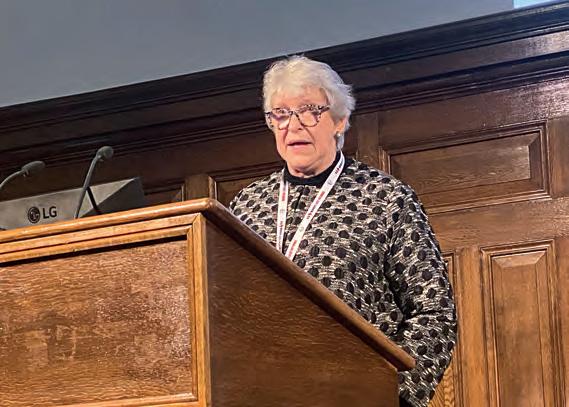
“Technology is both socially constructed and socially shaping. We the people should declare our agency”
building systems we either desire or require. “We’ve already started to build a symbiotic relationship with [IT] and each of us has our own unique relationship with IT. With the workplace we just need to apply the same principles.”
This year’s event was held both in person in Westminster and remotely, with host Simone Fenton-Jarvis taking over the helm from Martin Pickard, who was still involved in corralling thoughts from the online audience
Putting a human face on FM’s tech revolution
by Martin Read
The key is to tap into each individual user’s experience of their workplace – “but it’s only going to work by understanding people”.
Declaring our agency
Perhaps the most sobering presentation came from Workplace Law’s David Sharp, a man whose interest in artificial intelligence led to him taking a degree in the subject. For Sharp, there’s some cognitive dissonance between the growth in cloud computing, AI, and the pursuit of Net Zero. “Electricity and the resources AI consumes represent half a per cent of all global electricity consumption.”
Citing poor AI judgement in recruitment, Sharp added that “it is easy to see how the human gets lost in any conversation about tech”.
“Data is not neutral; it’s not like oil. There is no such thing as raw
WORKPLACE FUTURES 2024
10 FACILITATE MARCH-APRIL 2024 FRONT DESK / ANALYSIS

data. Every data element has the imprint of a human. Technology is both socially constructed and socially shaping. We, the people, should declare our agency here.”
Advanced Workplace Associates then invited us to prepare an AI audit for our organisations, breaking down the types of AI into five principal components: Machine learning; Natural language processing; Computer vision (eg, as used in self-driving cars); Robotics (physical task performing) and Deep learning (an advanced subfield of machine learning).
Tim Cook of nGage Recruitment tried to assuage attendees’ fears about their own personal understanding and ability to implement AI in their businesses. “You won’t be replaced by AI,” he said, “but you will be replaced by someone who knows what it is.
“Be careful of enterprise solutions; they are dangerous in a modern tech world. Think low code or no code solutions – because [with more bespoke solutions] you can be out of date before you’ve got it live.
“Technology doesn’t kill jobs, but it certainly changes them,”
added Cook. And, ultimately, “data trumps the technology that collects it: actionable insight is only going to be one or two things from a vast array of data”.
The skills imperative
IWFM chief executive Linda Hausmanis (pictured, left) added the critical issue of training to the growing suite of challenges faced by anyone running a future workplace, noting how employer training has fallen in the last decade, with training spend per employee plummeting 28 % since 2005. Projections suggest that by 2035 no fewer than two million jobs will have been displaced by automation, a figure disproportionately affecting men. We are, said Hausmanis, “sleepwalking into skills stagnation”.
“My challenge is this: How are companies going to deal with this lack of skills? How are you going to ensure those skills are delivered?”
Indeed, you might wonder. how much is it a skill in itself to understand the skills needs of others? (We’ve more on Workplace Futures online.)
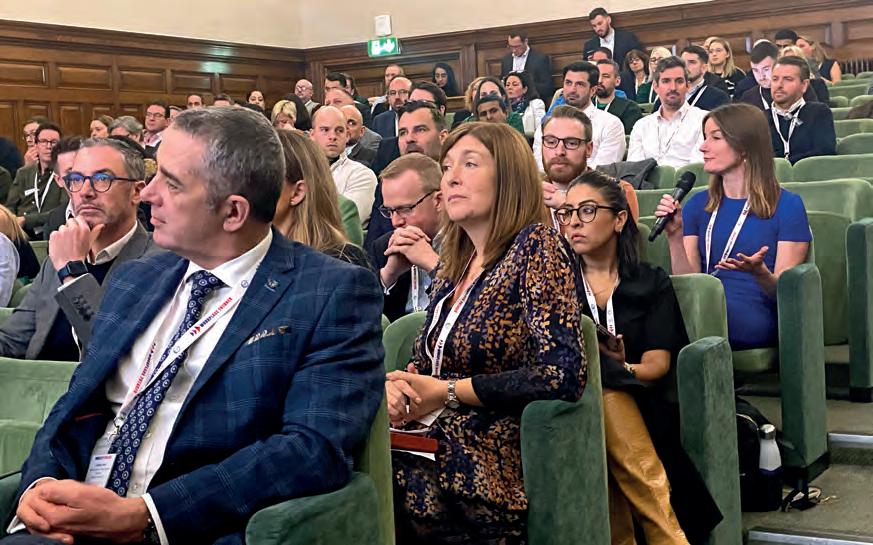
FUTURE FIGURES
WORKPLACE FUTURES STATISTICS
46%
Percentage of organisations with no hybrid working policy
37%
Percentage of organisations currently consolidating their workspace
1/3
Amount of UK company employees that will need to transition into new collaboration communication roles or skill levels by 2030, according to McKinsey
300m
Number of full-time jobs that Generative AI could replace, according to Goldman Sachs
81%
Percentage of FM leaders who consider robotics as a possible solution to cleaning issues in the next five years
IMAGE: XXXXXXXXX FACILITATEMAGAZINE.COM 11 ANALYSIS / FRONT DESK

Flexible working for the over-50s ‘must be a priority’
 by Herpreet Kaur Grewal
by Herpreet Kaur Grewal

Policymakers and employers are being asked to focus on flexible working as a means of recruiting and retaining older workers –who make up more than 30% of the working-age population.
In Flexible After Fifty, a report by the Chartered Institute of Personnel Development (CIPD) and members of the 50Plus Choices Employer Taskforce, 72% of over-50s in the UK want the option of flexible work to achieve a better work-life balance. A third (34%) cited caregiving responsibilities and a desire for more personal time as key drivers.
Jo Churchill, the UK’s minister for employment, and Andy Briggs, the government’s business champion for older workers, asked the task force to examine the importance of flexible working for over-50s and make recommendations for businesses and employers.
The task force is composed of representatives from a range of organisations with wide reach and influence: the CIPD, the British Chamber of Commerce (BCC), the
FRONT DESK / ANALYSIS 12 FACILITATE MARCH-APRIL 2024 IMAGE: ISTOCK
Federation of Small Businesses (FSB), the Recruitment and Employment Confederation (REC), UKHospitality, Institute of Directors (IOD), Make UK, and Business in the Community (BITC).
Championing workers
The group meets regularly with the minister for employment to discuss ways of championing work for this demographic, having gathered insights and distilled key recommendations in this new report.
Claire McCartney, the CIPD’s senior policy adviser, said: “People are living longer. The proportion of over-50s in the workforce is increasing and we know that flexible working is key to active participation for this group. If we want to benefit from their skills and experience, flexible working is pivotal.”
employers to do more to retain older workers – especially since the pandemic. Last year, think tank Demos argued that “we cannot afford to ignore the value of older workers – the ‘Platinum Pound’”. It suggested that, rather than convincing retirees to work,
SNAPSHOT
OVER-50S
33.2% (3.6 million) in the UK engage in part-time work
22.4%
Rates of homeworking among over-50s have risen from 10% in 2020 to 22.4% in 2023
9%
9% of over-50s use flexitime, which allows them to customise their start and end times within certain limits
new measures should focus on keeping people currently in jobs to stay in the workforce.
In separate but related news, the Equality and Human Rights Commission (EHRC) has issued guidance on menopause in the workplace, setting out employers’ legal obligations under the Equality Act 2010. This aims to clarify legal obligations and provide practical tips for employers so they can make “reasonable adjustments” and foster “positive conversations about the menopause with their workers”.
The commission suggests that if menopause has a longterm and substantial impact on a woman’s ability to carry out normal day-to-day activities, it may be considered a disability. Under the Equality Act 2010, an employer will be under a legal obligation to make reasonable adjustments and not to discriminate against the worker.
RETENTION
STAFF
There have been increased calls for FLEXING
AT 50
33.2%
(SOURCE: CIPD)
Safe Working Practices and Competency With Assured Training for the FM Sector
Last year, over 10,000 delegates chose PPL Training to deliver their Safe Systems of Work and Technical Compliance training.
You can train with us at our York and Slough Campus or Livingston Centre, with some of our courses available on-site at your premises and online via remote tutor-led sessions.
We were recently awarded City & Guilds Assured status, as an evolution of our long-standing relationship with the City & Guilds organisation.
13 of the UKs top 15 FM organisations were among our clients in 2023, as we provided training for over 1,200 of their employees. Will
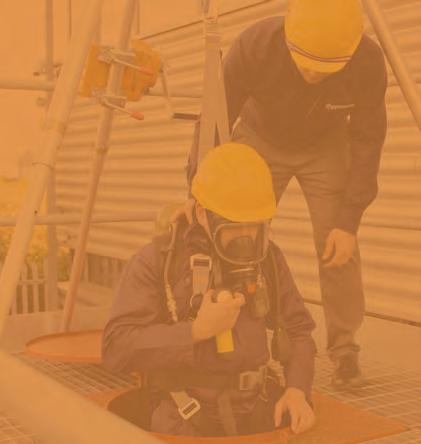


you
Demonstrate
join them in 2024?
Training for FM Contractors visit our website 0333 121 0381 Call our team today facilitate@ppltraining.co.uk go.ppltraining.co.uk/facilitate
Addressing competence through standards


IWFM’s head of policy and research, Sofie Hooper, summarises recent policy work and considers the institute’s role in the establishment of important new standards for the WFM sector
The focus of our recent work
The first two months of 2024 have seen IWFM’s policy work stretched across all aspects of the FM discipline, from asset management to workplace safety and all stops in between. If there’s a common theme it’s the development of standards: for information management, building safety, asset management and more. Establishing minimum levels of performance through standards is likely to be a core aspect of our policy work this year.
The very definition of statutory compliance has been under discussion. To this end our Procurement and Contract Management SIG has been bringing together key stakeholders towards a common understanding; the next step will be a review of our existing guidance on the subject, taking into account issues of definition and asset register management.
We’ve also spoken to the British Standards Institute (BSI) about BS8670, the upcoming standard covering the core criteria for building safety in competence frameworks. We expect this standard to be be launched in the next few months.
Also with the BSI we’ve been working with the FMB/1 working group on the various strategic activities of importance to FM that will influence new standards in the pipeline.
Then there’s our role in the Building Safety Alliance, especially our involvement in BSA Special Interest Group 3 (the development of the Building Safety Alliance golden thread tools), where our own Gordon Mitchell, Chair of IWFM’s Technology SIG is chairing the work on bringing together a single list of documentation and information requirements which enables organisations to demonstrate how they are
managing their building safety risks. This work is not carried out in isolation, but feeds into wider strategic projects, including the work carried out on the Transforming Infrastructure Performance: Roadmap to 2030, which is looking at improving the information management framework. We’re looking at guidance on information requirements and models and its wider impact for asset management.
The BSA has also been working on an organisational capability standard. The BSI has confirmed that it will take this forward as either a Publicly Available Specification ‘fast-track’ standardisation document, or full British Standard. I’ve also been speaking with former IWFM chair Stan Mitchell about the ongoing review of the ISO 40001 international standard for FM systems.
We’ve also got to ensure that our work within the BSA on competences is reflected and actioned in the social housing sector –another aspect of the culture change in the occupation phase of buildings that we need to get to grips with.
IWFM output I think you should see
We recently published our 2023 leadership and governance survey findings, outlining the state of equity, diversity and inclusion (EDI) in the leadership tier of our organisation. For this we were able to draw onto the expertise of our EDI Focus Group both for the input and the analysis of the report. I’d encourage you to check the details.
We also published our Sustainability Survey Report 2023. Its focus on two key issues – investment-readiness and the role of WFM in sustainability decision making – will resonate with a lot of people. It’s mentioned elsewhere in this Facilitate, but


































1. IWFM’s role in the Building Safety Alliance has been key to fasttracking development of golden thread tools
2. The 2023 Sustainability Report focuses on investment-readiness and WFM’s place in decision-making
3. Digital maturity depends upon the broader flow of organisational information requirements



IWFM POLICY UPDATE
1 2 14 FACILITATE MARCH-APRIL 2024 FRONT DESK / POLICY PIPELINE IMAGES: ISTOCK,
SHUTTERSTOCK


FURTHER READING
● Sustainability Survey Report 2023 tinyurl.com/Fac24104
● 2023 EDI governance and leadership survey findings tinyurl.com/Fac24105
● Volunteering with IWFM tinyurl.com/Fac24106
● Reasons for prioritising skills and training, by Linda Hausmanis tinyurl.com/Fac24107
● Enter the IWFM Impact Awards 2024 (April 10th deadline) tinyurl.com/Fac24108
GET IN TOUCH WHAT WE NEED HELP WITH – AND HOW WE CAN HELP YOU
We’re keen to hear from you about the topics you think we should cover, but this is a two-way street. In February, we began our campaign to convince more of you to take a volunteering role
with IWFM. You can make a difference within the profession by involving yourself with our regions, groups or networks –or by putting yourself forward as an awards judge or board member.
IWFM thrives through its volunteers, and we’re keen for more of you to step forward. As for policy, we welcome your thoughts on our future work –please get in touch. policy@iwfm.org.uk
the full report is a key part of our output and you are strongly advised to read it.
Also on our agenda
It’sworth explaining our role as part of the Building Safety Alliance (BSA). Recently the Construction Industry Council (CIC) published its competence steering group’s third report, entitled ‘A Higher Bar – Achieving a Competence-led Built Environment‘. This is something we’ve been involved in as part of CIC Working Group 8, a group set up to determine the competence requirements for the new role of building safety manager (BSM). We provided the secretariat and were one of the contributors of the first Competence Steering Group (CSG) report. Having delivered the competence framework for the BSM role (before the dutyholding role got removed from the Building Safety Act 2022), we continued to work on the wider areas we felt needed attention to work towards driving up competence and culture change standards across the operations phase.
It was having completed our mandate as working group 8 that IWFM and its other organisational partners transformed the group into what is now the Building Safety Alliance (BSA). We helped translate the BSM framework into PAS 8673 - ‘Built environment – Competence requirements
The very definition of statutory compliance has been under discussion
for the management of safety in residential buildings’ – working on the specification and competency elements of that (elements of which we’ve since added to our own professional standards framework) and collaborating further with partner organisations on further guidance.
Within this capacity we’ve also been working with DLUHC’s policy team on the building safety ‘golden thread’ list. We see this aspect of our policy development work as crucial.
What’s happening as you read this
Next time in these pages we should be able to report on the preliminary findings from our Market Outlook survey. Right now, we’re running a peer review session ahead of adapting our asset management good practice guide to take into account developments over the past year, seeking to ensure consistency with the guidance on information management systems, this being integrated into how we talk about asset registers and asset management more broadly.
The broader flow of organisational information requirements is a compelling issue for us; it’s about how solid, accurate information feeds through into project information requirements, FM information requirements, asset management requirements - all with an emphasis on how it flows back and forth between each. It’s key to our ongoing work on digital maturity.
Externally, we’ll be at the Workplace Event in Birmingham, where several of our regions and special interest groups will be presenting. We’re also working with organisers on the programme for the Euro FM conference that will place at London’s Metropolitan University in June
3
RESOURCES
FACILITATEMAGAZINE.COM 15 POLICY PIPELINE / FRONT DESK

WHO KEEPS THE LIFE-SAVING SYSTEMS WORKING SAFELY?
As the UK’s leading provider of specialist services for buildings, Premier Technical Services Group Ltd (PTSG) exists to protect people, property and places.
We work closely with buildings and facilities managers in every industry sector to ensure their assets remain compliant and safe for their users.
PTSG Building Access Specialists Ltd reaches all areas of every kind of building, from sports stadia such as Celtic Park (pictured) to historic monuments – and every structure in between. If our specialists can’t clean, repair or maintain it, no one can. business divisions.

NEWS IN NUMBERS
73%
Almost 73% of consumers believe that adopting a sustainable way of eating is urgent, Sodexo’s first annual Sustainable Food Barometer, which polled 1,000 UK people, reveals. One of its three main findings was that awareness of the “urgent need to change eating habits is not only well-established but positively perceived”
24HRS
Michael Gove has announced plans to introduce legal time limits forcing social housing providers to address hazards such as damp and mould, requiring landlords to investigate and make emergency repairs within 24 hours. The Awaab’s Law consultation is named after the two-yearold from Rochdale who died from a respiratory illness caused by mould in the flat where he lived.
66%
66% of FM heads had difficulty sourcing staff for support services and property management in 2023. Service provider SBFM has called on the sector to open up to a wider range of people to tackle skills shortages. Its report Evolve: Building a Better Future advocates for groups such as those with disabilities, ex-offenders and care-leavers.
51%
Over 51% of decisionmakers in retail recognise their role in the circular economy, a Biffa poll shows. Nine in 10 surveyed place waste management at the heart of sustainability, but say policy costs take priority. 64% say the circular economy is important to day-to-day business and 63% have a sustainability strategy.
1 MILLION
At least a million over-50s now run their own businesses despite an overall decline in self-employment since 2020, analysis by IPSE shows. Its annual survey found that the number of self-employed business owners aged over 50 surged to 1.1 million in 2023 – 89,000 more than in 2020.
SCAN
59%
UKGBC’s Whole Life Carbon Roadmap suggests that a 59% reduction in energy use in the office sector will be required by 2050, and that buildings are not being retrofitted at the pace or scale required to meet this target. UKGBC says 77% of UK office stock has an EPC rating below B and is likely to become unlettable by 2030.
32
PRACTICAL ACTIONS
In its new Disability Action Plan the government has outlined 32 practical actions that it says are aimed at making the UK the most accessible place in the world for disabled people to live and work
61%
Three in five frontline workers think information shared on workplace screens makes them more engaged with their wider business (61%), more productive (59%), and more data-literate (62%). The State of Digital Signage: 2023-2024, by ScreenCloud and Google ChromeOS, seeks insights on the tech equity gap between information and deskless workers.
20%
Nine in 10 adults sufferedhigh or extreme levels of stress last year, according to Mental Health UK. 20% of workers needed time off work because of poor mental health caused by stress. Those aged 35 to 44 were most likely to have felt high or extreme levels of stress and pressure often or always in the past year (40%) while workers aged 55 or over were least likely (33%).
THE FULL STORIES
FOR
FACILITATEMAGAZINE.COM 17 TOP STORIES / FRONT DESK IMAGES: NOUN PROJECT, ISTOCK








The last decade has seen mid-level FM service firms introducing trailblazing business models, embracing emerging new client concerns and injecting fresh impetus into the wider outsourced FM service market. How are they changing the game?



Bradford Keen and Martin Read investigate







ultural, environmental and legal drivers have had a significant effect on the outsourced FM market over the past 10 years. The Social Value Act of 2013 helped boost the link between FM’s frontline service and the locality in which it takes place, while the ramifications of Net Zero legislation are leading to fresh opportunities for the way facilities service is provided or buildings maintenance




conducted. The pandemic, meanwhile, helped give FM a new, albeit loose veneer of respectability in the public consciousness. All outsourced providers are responding to these factors by seeking to transform how they are structured, but it is in the emerging small to mid-market providers that the most striking new approaches can be seen.


New service models put forward by these firms are proving popular with clients. Some of this is being driven through the deployment of empowering


18 FACILITATE MARCH-APRIL 2024 FEATURES / CHANGING THE GAME






new technology, others by tapping into client awareness of how working with suppliers can help with their own social and environmental value obligations. In many cases, it’s both – and it’s being promoted by a new generation of young and hungry business leaders who, aware of the negative characterisation of the sector and those who work in it, are showcasing a more inclusive and progressive approach. Alongside them, other, considerably older and more established SME service suppliers have found ways to pivot to

take advantage of the more ESG-oriented service landscape, evolving their own service offer to counter those of larger and arguably more rigid competitors.







A QUESTION OF SCALE?
Before looking at what these ‘fresh approach’ service providers are doing to shift expectations, it’s worth considering other contributory factors. In particular, says consultant Lucy Jeynes of Larch Consulting, the current scale of some existing service firms may be limiting.



Through the many acquisitions and consolidations over the last few years, some larger FM service providers have “gone from big to huge,” says Jeynes, “and that’s leaving a lot of even quite big [FM service] clients feeling like they’re not very big anymore; that they’re not as big as their service providers”.



The result, Jeynes contends, is that “it’s much harder for a client to be the jewel in the crown of somebody’s business model”. What were once considered “trophy clients” to service providers are, she



FACILITATEMAGAZINE.COM 19 CHANGING THE GAME / FEATURES
BREAKING THE MOULD FOUR TO THE FORE
Consultant Lucy Jeynes runs the rule over some of the new generation of service providers.
“One thing common across these more innovative, bold companies – people like Matt Chapman at SBFM, James Bradley at Churchill, Andrew Hulbert at Pareto – they’re young guys, they’ve already got on faster than some of the people in the bigger organisations because they don’t have as many layers of the onion to work their way through.”

Arcus FM
“Arcus is developing really well. It’s kept its leadership team from inception and is culture and values-driven people”.
While not directly pitching for contracts on the basis of its culture and ESG credentials, Jeynes says these important metrics are clearly communicated in the way the company deals with clients.
younger engineers come to us, they like that we’ve got this really good technology’”.
An example is the AI-enabled work allocation app that helps engineers plan their day, pull up OEMs of an asset on their iPads to see its history and provide a route plan. Many say that DMA’s use of this technology is genuinely groundbreaking.
have a diverse team of people rather than other companies that say they have but then when they come out, it’s still five blokes named Geoff.”
DMA Group
This hard FM firm has, says Jeynes, “invested in a new management team and in new technology. They’re saying, ‘When
Pareto FM
“They don’t feel as much like a corporate machine, and they are genuine about their diversity and ESG. They’re not just doing it as marketing spin. Genuinely, if you meet people from Pareto, they
SBFM
This soft FM firm’s focus on EDI and the development of personnel from the front line upwards has put it and CEO Matt Chapman in the spotlight, with SBFM’s approach and business success in 2023 leading to recognition from several sources, including the Fast Growth 50, where SBFM was ranked the 23rd fastest-growing business in the north of England last year.
says, frequently struggling to get noticed by their FM suppliers.
Jeynes gives the example of one major global organisation setting up its offices in the UK and feeling somewhat neglected by one of the largest providers. This client, he reports, hadn’t heard from a contract manager for four months.
“He told me, ‘I should be more important than this. I just don’t feel like I’m on their radar as a significant contract – and I’m running the headquarters building of a really prestigious company in a really prestigious building’.”
The market has shifted, with the commercial size of a contract often trumping its historical prestige, Jeynes suggests. “Trophy clients” are now in a battle for the attention of their provider’s senior management and often struggle with a lack of continuity as a result of their contract managers being shifted to different contracts or promoted to new roles within the supplier organisation. Such clients, she says, can sometimes feel their contract is “just some kind of training
ground for engineers – and they’ve been really disappointed about that”.
All of this has led to some clients evaluating their options – and, through SME suppliers, enjoying a more direct communications link to the top of their service firm’s management. “Medium-sized companies coming up the ranks have an open goal to go for,” says Jeynes, “because they’ve got a shorter chain of command.”
AN ABILITY TO ADAPT
It’s not just the latest generation of SME providers who stand to benefit. Integral to
the success of Scottish-based Key FM is the firm’s 30 years of experience. Owner and former IWFM chair Stan Mitchell believes his is “the longest established” true FM business in the UK. “There are companies that have been other things and are in the FM market now, but most of our peer group have gone, either bought out or having gone out of business.
Mitchell believes there’s value in this independence. “We’d been approached several times [to sell the company] but we just were not in it to build an empire; we’re not in it to become millionaires. We’re


20 FACILITATE MARCH-APRIL 2024 FEATURES / CHANGING THE GAME
actually passionate about FM – our agenda is slightly different.”
Sometimes it’s not about bold business models but the simple ability to adapt quickly to client circumstances.
“If the client asks us to do something, the answer will be yes – with a quick pause to understand whether we can do it and what the implication is. The bigger boys, they’ve got bureaucracy that we typically don’t have.”
Mitchell talks of being asked to provide consultancy advice for a very specialist niche activity, and how “we gave them an answer within two hours.”
The more established providers have failed to shift with the times, or at least have been moving slower than their SME challengers to embrace all aspects of the ESG agenda, argues Jeynes. However, there’s no question that we are now seeing larger service providers rising to the challenge of evolving their corporate culture to match the cultural shift increasingly expected by clients.
THE BENEFITS OF BOTTOM-UP
Speaking of culture, Mitchell thinks one big change in the market is to business structure, in particular a move from ‘top-down’ management models, often characterised by the supplier management model that Key espouses, to the ‘bottom-up’ approach. The latter approach sees providers focused on empowering their own personnel through greater operational autonomy on-site, and more career opportunities.
“They’re the ones that have grown in the market for sure”, says Mitchell, who agrees with Jeynes that “it’s also due to “the big boys in the market getting too big, too bureaucratic, very slow to react and very diluted when it comes to people on the ground delivering services”.
There’s an issue of investing in staff here that goes far beyond just training.
For Dominic Ponniah, co-founder of service firm Cleanology – and recently judged IWFM’s Leader of the Year 2023 –recognition of the importance of investing in staff can still be a profound shift for many. Ponniah says the near doubling of Cleanology’s turnover in a year “is because we’ve invested in in the people we’ve got. We’ve over-managed it in a way and put more people in than we perhaps needed.



But [contract] retention is really key to growth, because unless you’re retaining business, you’re not really growing.
This link between the retention of staff and retention of business is an important one, says Ponniah. “As you grow, you need to keep changing your team,” he argues. “Sometimes people are not right for one point in the business but they’re right for another. It can be a tough decision to make, but you should be able to recognise that and move people around.”
“As we’ve grown, so many of our people have done so many different roles. There’s been a lot of opportunity for people who maybe came in as an area manager to become a mobilisation manager or run a special division. One guy started from there and ended up as ops director. It’s great when you can see that progress.”
WINNING THE WAR FOR TALENT
Ponniah’s attitude to its people, allowing space for individuals to grow within the
organisation, is mirrored by others, as we shall see in the following pages. And Jeynes sees this approach to developing people, in both management and frontline service roles – helping build careers while accepting that some of those that have been invested may still leave – as a major point of differentiation for the new generation of providers. It’s an approach that demands a new and confident, perhaps even defiant outlook from those who run such businesses.
It’s also an approach having an impact on recruitment. Jeynes cites Pareto FM as “one of the most obvious” new generation service firms “really getting a steal on that battle for talent”.
“I think it’s easier for a broader range of people to feel at home in a company like that than it is in a kind of monoculture of bigger organisations.”
A TASTE FOR ACQUISITION?
A further consideration is that some of these high-performing disruptor providers are going to be increasingly attractive to larger companies as potential acquisitions. Is there potential here for a change in the eternal cycle of bright young FM service businesses eventually succumbing to the advances of larger firms keen on absorbing whatever USP the smaller competitor had? After all, this time part of the value in the latest wave of emerging service providers seems to be in their smaller scale itself, as the firms win social value plaudits and sustain closer connections to their clients.
Still, says Jeynes, “the best way to take them out of the competition is to swallow them. Some of those companies are showing themselves off for sale, and who wouldn’t?” The traditional cycle of growth and acquisition can still work well for both parties and the wider market, creating a “mushroom cloud” effect whereby the newly enlarged acquiring provider sits at the top creating a “vacuum underneath” for another generation of smaller companies to make their mark.
What is it, then, that differentiates the service firms currently shifting perceptions of the FM service model? And who are some of the characters leading these ‘challenger’ suppliers? That’s the focus of our following pages.
CHANGING THE GAME / FEATURES FACILITATEMAGAZINE.COM 21








With environmental, social and governance principles being vigorously pursued by all facilities service providers in 2024, it’s the personal zeal of individuals in the sector’s mid-market challengers that’s really standing out, as Bradford Keen and Martin Read report







22 FACILITATE MARCH-APRIL 2024 FEATURES / CHANGING THE GAME
It’s often said that a successful business leader is one whose impact on their organisation’s culture is so powerful that it is felt beyond their physical presence. Right now, the facilities sector is blessed with a growing cohort of talismanic leaders whose influence on their businesses is extending to the wider sector itself.
There is no doubting the impact of businesses such as Pareto, of IEM, Arcus, SBFM, DMA and others. As an indicator of their impact, look to the sector’s various awards schemes: their innovation in service delivery, use of technology and attitude to their own and their clients’ employees has seen them lavished with praise. Some, like Pareto, were born in their leader’s image; others are existing suppliers transformed by the recruitment of individuals unafraid to challenge the status quo and create an inclusive environment from management down.
Pareto’s Andrew Hulbert is an obvious example of the former, the success of his business making ‘Pareto’ almost synonymous with this new facilities service order. For the latter, many cite Matt Chapman, chief executive of SBFM. “He has a really interesting take on how to run a soft services company,” says Lucy Jeynes of Larch Consulting.
‘CELEBRATING ATTRITION’
The prevailing narrative among soft services providers is of addressing staff churn through better retention strategies and seeking to solve the persistent issues causing people to join and leave. Chapman’s approach is quite different, says Jeynes. He even talks of ‘celebrating attrition’. Says Jeynes: “He just says, ‘That’s what the industry is like. We know that one in 10 people is going to leave cleaning entirely while they’re working with us. So we’re developing ways of working that incorporate that.’”
Counterintuitively - at first sight, in any case - Chapman actively encouraging the ‘poaching’ of his staff by his client organisations. Says Jeynes: “His thinking is: ‘What if we could help our clients become a channel for recruitment? What if we can highlight our talent for them, and encourage all the people in our cleaning and hospitality team to apply for jobs in
the client organisation, and help them to build their careers?
The difference is making the recruitment trend work in his favour, rather than expending any effort on trying to change it. “He’s much more realistic about it,” Jeynes believes. “He’s giving his people access to training courses in things that won’t necessarily help them become a better cleaner, because he’s thinking, ‘Well, why wouldn’t you help people develop?’”
Interestingly, Chapman says that SBFM is now taking on employees directly from their own clients. At the same time, he’s also able to demonstrate a big increase in the number of women in leadership roles across his business.
THE HARD FM REVOLUTIONARY



STEVE MCGREGOR, MD, DMA GROUP
Sniffing an opportunity to change a tired approach to maintenance, McGregor and his colleagues have made a well estaboished SME supplier stand out in fresh ways.
● Most maintenance customers are unsatisfied. They increasingly expect more for less, yet better, and that requires a complete re-boot.
● The UK maintenance industry hasn’t changed for decades. It’s been procured and delivered in the same way. A ‘vanilla’ service prevails with little differentiation between providers other than their scale or the colour of their workwear.
● Our drive to be ‘better’ triggered our digital transformation seven years ago. We built our own cloud-based service management platform, called BiO®. It’s doubled our efficiency.
● Our industry is way behind the tech curve. We intuitively knew what needed to be fixed; fullscale digitalisation was the answer.
● Process automation takes a lot of time. Defining and refining workflows for every business process involves everyone; you have to get back to basics.
● It’s lonely being a disruptor in our industry. Many organisations are content maintaining the status quo. Some believe they have no choice, that there’s too much risk.
● Innovating is hectic. You need resilience in spades because it’s beset with highs and lows.
● Our aspiration remains ‘smashing the UK maintenance industry’, not through arrogance, but simply recognising we must change. With 220 years under our belt, we consider ourselves the oldest start up in history!
● Achieving an employee NPS score of 52 and a
customer NPS score of 47 means we’ve got it right. But we know we’ve still got more to do.
● Wholesale change is too risky for most large businesses. The sheer scale of transformational change amidst a myriad of legacy systems is just too hard to achieve.
● The agility of an SME is a real advantage. You can fail fast, fix and move on. You’re closer to your people, your service partners and your customers.
● In simple terms, we think big, act small – and then we can scale fast.
● Making quicker decisions without everything going to committee stands out as a core difference from my experience. We are here to deliver hard and fast.
● For some large players it’s just too hard and too risky. On the flip-side, the typical small player does not have access to the skills, vision or budget to invest to that level.
FACILITATEMAGAZINE.COM 23 CHANGING THE GAME / FEATURES
DEMANDING BETTER
This focus on the social side of the ESG spectrum comes as clients become increasingly demanding about the approach to the issue from those they partner with. Cleanology’s MD Dominic Ponniah is another who doesn’t think twice about this approach when he applies it to management positions.
“There’s definitely a much stronger focus across the whole industry, both big and small, on diversity, ESG and all these things we’ve been talking about for yearsand that’s lifting the sector in general.
“It’s rare that I go into a new client pitch and talk about their skirting boards and how they’re going to be kept clean. Strangely, we very rarely talk about cleaning. It’s everything else that we discuss - around our people, diversity, sustainability, all those things.”
Also, says Ponniah - where’s the downside in staff development?
“From my point of view, I feel like I kind of owe it to them,” he says of his own approach to personnel development. “They’ve given me blood, sweat and tears, and they’ve worked really hard in









their role to do a great job. Surely the thing you’d want to do is promote them and give them a chance to the next level, rather than bringing in new people?”
SMALL FOOTPRINT, BIG DIFFERENCE







Sometimes an aspect of an SME service provider’s basic structure becomes more attractive to potential clients over time.


ANDREW HULBERT, VICE CHAIR, PARETO FM
The former IWFM leader of the year and Facilitate rising star, now IWFM board member, has been at the forefront in embracing ‘socially led, relationship based’ facilities service provision
● The leader of an SME needs to be able to see things that others can’t; and be determined to make it happen and dedicate themselves to making it work. Without them, no one will have the drive to do what needs to be done.
● An SME may have around 50 to 100 staff whereas a larger provider could have 50,000 to 100,000. Just by the very nature of this, SMEs can be significantly more adaptable.
● When total team size is up to 100 people it’s possible to
contact every single person in the business and coach them through changes. Rolling out training on new processes is simple comparative to larger businesses.
● Ultimately, SMEs can make wide scale changes quickly, including collaborating with all company team members and rolling things out quickly.
● Often SMEs will start with one service line for which they are experts. The SME delivers well and impresses the client because they are specialists in


that one area. The client then realises the SME is capable of delivering to a higher degree than the larger providers they are using and look to give more services to the SME.
● If an SME can take advantage of that opportunity, and adapt to client needs, they’ll derive significant competitive advantage. This in turn will drive monumental growth.
● Social value in SMEs is usually very genuine as it’s come from the values of the owner of the business. This drive for social success can properly be achieved alongside business success too.
● Often in larger providers, social value can feel like a tick box marketing exercise. In SMEs the value is real and can be felt.
Eric Wright FM (EWFM) is one of seven divisions trading under the Eric Wright Group, which is wholly owned by a charitable trust with no shareholders. Of its roughly £10 million annual profits, around £3.5 million goes into the trust with the balance funding new projects.

● The industry is definitely seeing a drive towards a greater focus on demonstrating ESG. ESG is becoming a prerequisite in the market due to the innovative drive of SMEs to bring it to prominence.
● ESG is no longer about just having a few apprentices and doing a charity run. It’s about demonstrating that your culture truly is making the world a better place. It’s easy for SMEs to do this as they’re built on those foundations.
● We’re seeing larger providers scrabble around to demonstrate a positive ESG story. Often those social principles can be lost as businesses go through growth; trying to reinstate them at the back end of growth can come across as insincere.
THE SME ADVANTAGE
24 FACILITATE MARCH-APRIL 2024 FEATURES / CHANGING THE GAME
Says director George Lilley: “There are not many FM providers, if any, that have the same sort of model.”
The model is appealing to many for its altruistic and community-focused outputs. Being owned by the trust “makes initial conversations [with clients] very easy,” says Lilley. “It gets you through the door”.
For Lilley, smaller suppliers have a lot to offer the typical 2024 client. “The big bigger providers, they have a model, and that model is very good - but it’s probably a 67% fit to what the customers want and then their customers get agitated that the 30% is not there.”
There is also a contemporary approach to franchising as espoused by Scottish firm Tidy Green Clean (TGC). Run by Andrew Alleway and his brother-in-law David Moncur, TGC made its name with an emphasis on environmentally-friendly processes, local employment and a culture where no one wants to leave. (Like many such suppliers, TGC boasts a staff retention rate that goes well against the norm, in this case 93%.)
Are such firms active disrupters of the existing facilities service paradigm?
“I don’t like to be a disrupter. I like to be a leader,” Alleway says. “I like to be a bit more visionary as a business, and we have a clear path of where we’re going.”
ATTRACTIVE PROPOSITIONS
While the scale of larger providers means that they can afford to lose some contracts to SME challengers, they may be more worried about losing talent. And here’s where these smaller but culturally more appealing firms may have the edge, Jeynes believes. This new breed of suppliers “are fishing in a bigger pond and making bolder decisions about who they recruit. Therefore, they aren’t having the resourcing gaps that other companies are having. They’re saying, ‘We can fill gaps other people can’t because we make bold decisions about who to recruit and we recruit for fit and give them the skills and make them feel welcome and we have less churn’”.
The effect that these firms and their leaders are having looks set to continue causing ripples as the client focus on ESG grows in importance.

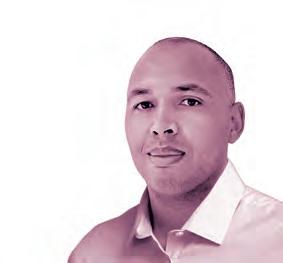



PROMOTING FROM THE FRONTLINE MATT CHAPMAN, CEO, SBFM


● The pandemic shifted people’s viewpoint of this sector. And now. if we look at the economy and do a PESTEL analysis [political, economic, social, technological, environmental, and legal], you can see the pressure on business that’s been created. it’s like we’ve created this melting pot of issues that this industry can help solve for an awful lot of people.
● We’re not going to focus on retention, we’re going to celebrate attritionjust as long as anyone who leaves us has had a positive experience of being with us.
● We’ve someone starting with us tomorrow who’s come directly from our client. We’re seeing an uptick in people who see what we’re about, that it’s


While SBFM is in its eleventh year, Matt Chapman has only been there since 2022 – but his impact on the sector and his approach to the market is making waves
not just about money but also about purpose. I think that’s quite special.
● We’re asking people to get to know the workforce help them progress, just like we would like to be progressed and interacted with, because they are humans.
● There is an advantage to us being an SME provider. We’re not governed by some invisible board, it’s myself and the owner who will say, this is how we want this business to behave, these are our values, this what we expect.
● We look outside of our industry for a lot of our advancements. We’re not necessarily looking at what the larger firms are doing. We look outside of our sector for fresh
inspiration about what can be achieved.
● When we recruit, we’re talking about diversity - of thought, religion, gender, however everyone identifies. But then I also want a likemindedness amongst our people, with those we employ working to what our principles are.
● The proudest moment for me will be when an SBFM cleaner or security op progresses into a leadership role here, promoted from within.
● We’ve got people working on our contracts at the moment who are homeless. We’ve helped them register a address, set up a bank account… and their stories will help us to attract other people.
● If we really want to create change, it can’t just be about what’s in it for us. My belief is that SBFM will continue to think differently and look at innovative ways to help people progress.
FURTHER READING ONLINE DOCUMENTING THE DISRUPTERS
The larger service provider perspective
Challenger firms explain their approach
How SME providers are changing expectations facilitatemagazine.com FACILITATEMAGAZINE.COM 25 CHANGING THE GAME / FEATURES C HAN G I
●
●
●
February 2024 saw publication of two reports, IWFM’s sustainability survey analysis for 2023 and the UK Green Building Council’s Building the Case for Net Zero: retrofitting office buildings.
The former speaks to the evergreen issue of facilities managers being frustratingly distant from corporate decision-making on environmentally beneficial projects, too rarely taking a lead role in such projects’ development. The latter homes in specifically on the value of retrofit projects in pursuit of the net zero office.
The common issue linking both reports is how different levels and types of project investment – and in turn how projects are then structured – can have a material effect on outcomes.
One solution on the horizon is the UK Net Zero Carbon Buildings Standard, due at some point this year (and with a Beta testing phase set for spring). Championed by

The impending
launch of a UK Net Zero Carbon Buildings Standard
should give office owners and
occupiers a way to
assess their built assets
to ensure
that they are, or are on their way to being, net zero carbon. Buildings that don’t match up are likely to be seen as materially less attractive to investors, triggering competitive pressure to conduct retrofit projects. Nick Martindale reports
26 FACILITATE MARCH-APRIL 2024 FEATURES / OFFICE RETROFIT
the government and developed by a powerful group of organisations from the Better Buildings Partnership to the Carbon Trust, its aim is to introduce a standard that is structured by using science-based targets and limits.
Phil Clark, a director at design consultancy Arcadis and member of the UKGBC’s commercial retrofit task group, believes investors, landlords and tenants should all have their own reasons for wanting to demonstrate their office buildings’ progress towards the forthcoming standard.
“There’s a close correlation of data between the very best-quality offices, which are letting well, and the secondary market, which is struggling,” reports Clark.
“An easy way to show you’re reducing your carbon impact is to demonstrate that the buildings you’re invested in or developing are leading the way in terms of the standards. I think the market expects that.”
Additional pressure on building owners from investors is the steady drive towards reporting on
Scope 3 emissions. Chris Newman, zero carbon design manager at Mitsubishi Electric Living Environmental Systems, thinks it comes down to a basic equation.
“Banks and financial institutions look at their investment portfolios as their Scope 3 emissions,” he says. “If a pension fund is providing a lot of money in the commercial property sector, the carbon emissions of that investment make up the Scope 3 emissions of that pension fund, so there’s a drive to make sure that they’re investing in lower-carbon assets.”
In future, believes Newman, commercial loans for buildings will be offered at preferential rates if a building is aligned with a net zero or decarbonisation strategy. “It makes it a de-risked investment from the lender’s point of view,” he adds.
For most landlords or tenants, this will mean looking to improve existing buildings. The UKGBC’s office retrofit report puts a figure of 77% on the amount of UK office stock that currently has




FACILITATEMAGAZINE.COM 27 OFFICE RETROFIT / FEATURES
IMAGE: ISTOCK, NOUN PROJECT
QUICK WINS
OFFICE RETROFITTING NEEDED AT ‘PACE AND SCALE’
The UKGBC report talks of “significant opportunities” being missed by office investors, owners, and occupiers, chiding them for not having “clear retrofit strategies in place”.
Even some of the least costly “easy wins” are not being pursued, with organisations failing to use key “trigger points” in lease and maintenance cycles to facilitate easier, more efficient retrofit.
UKGBC’s own ‘Whole Life Carbon Roadmap’ suggests an overall 59% reduction in energy consumption in the office sector will be required by 2050. The office retrofit report says commercial buildings are not being retrofitted at the pace or scale necessary to meet this target.
The theme being pursued now is of organisations being left with stranded assets as the impending UK Net Zero Carbon Buildings Standard, and new minimum energy efficiency standards (MEES), change how the corporate real estate market values buildings.
The report focuses on three levels of retrofit: optimisation, light retrofit and deep retrofit. Reductions in operational energy use are possible through both optimisation and light retrofit (26% and 15% respectively), with these generally including “the most cost and carboneffective retrofit measures”.
Then there’s ‘Deep retrofit’, seen as being required to achieve major cuts in operational energy use (60-65%), transition building systems away from fossil fuels, and meet best practice 2030-2035 energy performance targets for offices.
Yetunde Abdul, head of climate action at UKGBC, argues that the scale of the challenge and the rate of decarbonisation required means that ambitions need to be redoubled, without overlooking easy wins.
“If all stakeholders are prepared to collaborate and be transparent, there is huge long-term environmental, social and economic value to be secured.”
an energy performance certificate (EPC) rating of B or below, a metric that suggests such property will be unlettable by 2030. What this should suggest is a lot of retrofit work taking place in a short period of time, and all of it conducted in the light of continuing uncertainty about office occupancy patterns.
The UBKBC report breaks down retrofit work into three strands, from optimising the use of buildings (which can achieve operational energy reductions of 26%) through to light retrofitting (another 15%) and ‘deep’ retrofit, in which further efficiencies can be derived from more extensive overhauls and shutdowns of buildings (see box, ‘Deep Impact’).
FM’s role
Facilities managers have an important role to play here in highlighting the issue to clients or management, underpinning this reporting with meaningful operational data.
“Effectively decarbonising a building first depends on having the data from a proper energy audit, highlighting and prioritising demand reduction and conservation measures,” says Steve McGregor, managing director at DMA Group.
“FMs are typically in a great position to directly influence retrofits if they are properly engaged
during the early scoping, briefing and design phases. Sadly, 95% of all the useful building data already gathered isn’t used, so we need to ruthlessly define what’s important to influence the design sufficiently to operate buildings better.” He believes FMs need to be integrated into every retrofit activity.
Newman agrees FMs are pivotal to collating and analysing data before identifying potential changes.
“The old adage is that you can’t reduce what you don’t measure so you’ve got to make data-based decisions,” says Newman. “FMs are the ones monitoring existing equipment on sites, who have access to the building management system data and the trends and type of operation of the building. A big part of it will be measuring the improvements and being able to demonstrate those.”
The ROI of retrofit
This kind of information can also be used to make a business case for the financial viability of retrofitting projects. Marc Watkins, business development director at Service Works Global, cites existing return-oninvestment calculations manageable through computer aided facility management (CAFM) tools, weighing the costs of inaction against upfront investment and anticipated operational savings.
UKGBC figures on gains still to come from low-costoptimisation ‘quick wins’ stand out here.
“Identifying areas for improvement during routine maintenance activities can streamline the retrofit
26% Average
37%
Average
RETROFIT EFFECTS DEEP IMPACT
reduction in energy use intensity (EUI) from baseline through use of optimisation measures alone
reduction in EUI from baseline through optimisation and light retrofit 28 FACILITATE MARCH-APRIL 2024 FEATURES / OFFICE RETROFIT
“Some of the bigger impacts will come when initiatives can be grouped together”
process,” adds Watkins. “The number one thing to do is to look at how you use the building. In our office in London, Friday is the quietest day. We’ve got two floors in our building, and we consolidate them into one on a Friday for that very reason. All the lights are off on that floor, and we turn down or off some of the tea points.
“Quick wins often involve straightforward upgrades such as transitioning to LED lighting, improving insulation and implementing sensor systems for heating and lighting control. These measures not only reduce energy waste but also enhance comfort and productivity. Maintenance based on usage rather than frequency is another pragmatic approach, ensuring resources are allocated where they’re most needed.”
Stephanie Welch, head of workplace and FM at Arup, highlights measures that can be implemented when facilities come to a point where they need an overhaul anyway. She sees these trigger points as a major reason why many quick wins still have yet to be realised.
“If you’re replacing your toilet, can you go for an air flush toilet?” she asks. “Can you go for waterless urinals? We introduced a water tap in our café and, as a result, the sale of plastic water bottles went down by 60%. Can you bring your lux levels down by 5% or switch your boilers off in the summertime to stop any unwanted heat coming on?”
There’s also potential from reusing equipment, such as work surfaces, taps and sinks, and even reupholstering furniture, she adds.
60–65%
Some of the bigger impacts, though, will come from larger projects, or when initiatives can be grouped together.
“If you fit a heat pump instead of a gas boiler, that might give you a carbon reduction,” says Newman, “but it might cost quite a lot of money to buy and operate. However, if you team that with reducing the heat loss in the building by improving the fabric or replacing the heat emitters so they can operate with lower flow temperatures, it has a much bigger impact.”
In search of a unified strategy
Whatever these calculations, budget is always going to be an issue, says Welch; and all the more so since the UK officially entered recession.
“We will have an issue with landlords that don’t want to do anything,” she says. “We have a lot of small businesses where green credentials are not going to be the first thing on their list.”
It’s important here that FMs can share success stories – including demonstrating monetary savings – because in some organisations there may only be a skeletal team without much knowledge or experience of such topics, she adds.
The lack of broader business buy-in can also frustrate progress, says Watkins. “The absence of a unified strategy across stakeholders and unclear decision-making processes can impede progress. Limited expertise in-house, and outdated or incomplete building documentation, further compound these challenges. Aligning retrofitting efforts with broader organisational goals becomes challenging without clarity on government mandates and incentives.”
There are practical issues, too. Clark identifies the murky division of responsibilities between tenants and landlords as one, and also the need for collaboration between multiple tenants. “If you’ve got people occupying a building
13%
Average reduction in EUI from baseline through optimisation and deep retrofit (a)
Percentage of useful building data being gathered that isn’t actually used 1 IN 3 WFMs were ‘ordinary stakeholders at best’ when drawing up energy efficiency and carbon reduction plans (b)
95%
Percentage of WFMs who led the process of drawing up plans (b) Notes: a. UKGBC’s Building the Case for Net Zero: retrofitting office buildings says optimisation and light retrofit can be led by landlords or tenants. Deep retrofit requires moving away from fossil fuels to meet 2030-2035 office energy performance targets, which UKGBC says ‘average’ retrofit projects do not currently meet. The UK Net Zero Carbon Buildings Standard is anticipated to align with these targets. b. IWFM Sustainability Survey 2023 Report
FACILITATEMAGAZINE.COM 29 OFFICE RETROFIT / FEATURES

“Banks and financial institutions look at their investment portfolios as their Scope 3 emissions”
in different ways, that’s going to impact the performance,” he says.
The UK Net Zero Carbon Buildings Standard only considers buildings as one entity rather than by occupier, which will make investing in retrofit projects less attractive for some tenants.
In at the outset
There are also concerns about the extent to which FM is involved in such initiatives at all. The IWFM’s Sustainability Survey Report 2023 found that one in three FMs were ‘ordinary stakeholders at best’ in the drawing up energy efficiency and carbon reduction plans, with some still not involved at all. Just 13% led the entire process of developing plans.
The findings prompted IWFM CEO Linda Hausmanis to issue a rallying call to both FM practitioners and organisations more generally. “We call on all WFMs to put their value into action and take up the opportunity to create and drive forward organisational transition plans,” she says in the report’s foreword. “The lack of ownership for net zero delivery within organisations revealed by our research shows a gaping opportunity for our profession. To business we say, don’t take forward any plans without putting your WFMs central to them. You want to see a
clear return on investment, after all.”
For her part, Smith Mordak, chief executive of the UKGBC, recognised the complexities specific to office ownership and occupancy in her organisation’s report.
“We need to share data more transparently and effectively across different stakeholder groups,” she says in the UKGBC report’s foreword.
“Office buildings are complex dynamic systems that include physical, technological, and human components. Lack of transparent data is preventing key feedback loops, for example, occupants or facilities managers being able to see the impacts of their actions to empowering them to change their behaviour and how they use the offices accordingly,” Mordak adds.
Ultimately, real progress will come from organisations that recognise the way the wind is blowing. Newman believes that there’s an opportunity for FMs to have more forward-looking conversations with landlords, as well as internally or with clients.
“They need to be asking what the plan is for the building for the next three or five years,” Newman explains. “Is there an aspiration as to the energy usage that the building could have, and what can we measure now to help you make decisions in the future? If you tell us what good looks like, then we can hopefully deliver that. Not much of the supply chain talks to the building landlords.”
There’s a frustration that’s palpable in all of this. In the IWFM’s sustainability report, Sunil Shah, Sustainability SIG member and director at Acclaro Advisory says “FM teams know how systems are designed. It is all directly under their control. They don’t need to speak to other people about it”.
The issue is whether another new standard can genuinely address this disconnect between the FMs who know the capacity, capability and longevity of the systems they have in place, and the organisations who need to know all of this to make practical plans.
RESOURCES
FURTHER READING
● ‘Building the Case for Net Zero: retrofitting office buildings’ UK Green Building Council tinyurl.com/Fac24109
● IWFM Sustainability Survey 2023 Report tinyurl.com/Fac24104
● The UK Net Zero Carbon Buildings (NZCB) Standard tinyurl.com/Fac24110
For Welch, at least, the new standard will have some effect, for some buildings. “It will have an impact for those people that are already on that trajectory,” she says.
“I do wonder how much [effect] it will have for those people who are sitting on the fence and waiting to see what happens. But it will make a difference to some of the larger companies. And for those that have some younger FMs, they’re going to be all over it.”
30 FACILITATE MARCH-APRIL 2024 FEATURES / OFFICE RETROFIT

2023 Workplace Index | Q4
Get the complete picture
Executive summary
Over the past year we’ve used proprietary data and commissioned research to explore the twin challenges of how to use space more efficiently in a hybrid working world and how to manage facilities and assets more effectively.
Our first report identified four key opposing demands faced by business leaders and examined how, with better data, organizations could balance these demands by gaining a deeper understanding of their worlds.
Freedom and connection
Flexibility and certainty
Value add and cost control
CO2 targets and costs
Q4
In Q2 we took a deeper dive into the demands for freedom and connection. Drawing on our own extensive data across 16,000 customers, we highlighted trends by industry on desk utilization levels and room booking data, as well as looking at visitor data across the globe. This data was supplemented with independent quantitative research on employee attitudes and expectations to working in the office. The report emphasized the need to use technology to help employees and employers find the right balance between the flexibility of working from home and the benefits of being together in the office.
For Q3 we explored the demands of value creation and cost control in more detail, specifically the significant operational challenges businesses face in asset management and workplace management. Once again, we supplemented our proprietary data with bespoke research, uncovering interesting behavioural insights into how employees use their workplaces, and operational insights into how businesses can best optimize their use of space and how they can deliver highly effective asset management strategies.
With Q4 we’ve summarised and updated our proprietary data across the four demands, bringing 2023 to a close with up-to-date insights.
Scan to download the full report












MAXIMUM FLEXIBILITY



There’s a sense of the future knowledge workplace paradigm remaining ce stymied by an ever-present state of uncertainty. How can organisations fi x their future facilities’ format with so many shifting organisational, environmental reports
There’s a sense of the f uture k nowledge paradig m remaining out of reach, the optima l desig n for the f uture office an ever-present state uncertainty. How can organisations fi x their f uture facilities’ format with so many shif ting organisationa l, environmenta l and worker priorities? Flexibility is a ll, as Greg Pitcher repor ts r




32 FACILITATE MARCH-APRIL 2024
FAC ILI LI TAT T TA E MA RCH -AP AP RIL 20 2 24 FEAT U RE S / FUTURE DEMAND S

Much continues to be said about the need to define clearly the purpose of the mid2020s post-pandemic office. It’s a debate with both a human and commercial dimension, the two intrinsically linked.
The main issues are about certainty and preference. There are increasingly sophisticated tools to calculate the demand for more worker-specific environments (designs that incorporate worker personas; workplaces designed to meet the broad character traits, etc.) –but those preferences are subject to the unsettled nature of working group team structures and individual preferences themselves, affecting the certainty upon which funding decisions can be made.
At the very least, research by Cisco suggests that fewer than 30% of firms now expect their workforces to be at work fully in person over the next five years. The overriding theme? Putting people ahead of place – and commissioning accordingly.
Our 2020s technology in all its myriad forms allows, in theory, the design of a worker experience around individual user characteristics, or a particular kind of workplace team’s space to be built around a broad understanding of that team’s likely character set. But the collective preferences
of a company’s community of workplace users will surely shift year on year as the workforce changes. Workers will leave, and new recruits may have different personal preferences of what they want their workplace to be. A carefully constructed, multilayered workplace format may yet need constant revision as team and individual users’ dynamics change.
Is this a practical consideration? Are expectations for the workplace needs of specific job functions within the office likely to hold fast? What, then, are the fundamental requirements of the 2024 knowledge workplace? Do they transcend this lack of certainty?
Hybrid – the jury is still out
Despite the overwhelming embrace of hybrid for knowledge work in the postlockdown landscape, the model has far from settled into a standard. Many business leaders still have their sights on adjusting how and where workers work. These repeated attempts from larger corporations and the public sector to oblige workers to spend more time in the office include His Majesty’s Revenue and Customs, now working on ‘return to office’ plans through which 60% of workers’ time is based on being physically ‘face to face’ with colleagues, rather than home.
A study by the Chartered Institute of Personnel and Development
IMAGE: GETTY IMAGES FACILITATEMAGAZINE.COM 33 FUTURE DEMANDS / FEATURES
(CIPD) last year showed that more than four in five organisations had deployed hybrid’s ‘part-central, part-remote system’, with a fifth of employers having immediate plans to invest in driving greater hybrid activity.
One part of the equation is the synergy between HR and FM departments. Claire McCartney, senior policy adviser at the Chartered Institute of Personnel Development (CIPD), says HR chiefs have a key role to play in collaboration with FM teams when designing office spaces and systems to suit staff, offering a five-point plan for such collaboration (see box, Five point plan).
“We need to consider how to plan our space and surroundings to get the best from our people,” says McCartney, “and a key part of achieving this will be asking employees for feedback about office space, design and layout and feeding that into their plans.”
Ah, says McCartney, but “to review and make any necessary changes on an ongoing basis” is key. And that’s where the difficulty lies.
Use pattern pains
Tim Oldman, chief executive of workspace consultancy Leesman, has long warned of a calamitous shift in the demand for offices as legislation around the environmental performance of buildings joins with newly permanent shifts in usage patterns to lock in a measure of uncertainty. He says that a raft of changes is needed from employers to keep up with evolving employee expectations. “Now that the workforce has become accustomed to the ease and comfort of working from home, an unclean, faulty, uncomfortable and inefficient office will no longer be worth commuting in for,” he says.
The problem is that, despite a tsunami of commentary since the pandemic, the design of the physical workplace “remains fairly similar to a decade ago,” says Oldman. Right now, “the biggest task is to optimise office space to facilitate the unpredictable patterns of hybrid teams”.
Oldman adds: “Hot desking and flexible workspaces have become more popular in an attempt to accommodate this wavering demand. However, there has been a pushback from employees who
FIVE-POINT PLAN
The 2024 office fundamentals that both HR and FM departments need to consider
● Do people have the space and resources needed to carry out their roles?

● Is the environment supportive of wellbeing?
● Have all EDI considerations been considered and accommodated?
● Quiet and riot: Does it provide options for concentrated work, yet also aid collaboration, communication and creativity?
● Are teams co-located?
often want a space to call their own.”
Oldman predicts that, ultimately, most organisations will settle somewhere between complete choice and strict attendance, leaving FMs essentially tasked with creating seamless, easy-to-access hubs. This balance is not something that will settle; an element of uncertainty is likely now to be a permanent part of knowledge workplace provision.
Making this reality more acceptable, says Oldman, will come down to the use of smart technology to ensure the necessary levels of flexibility within a reasonable budget; for example leading to improved maintenance responses and better, more incremental delivery of heat and light.
“Technology that measures and analyses workspace usage gives FMs valuable insights into trends on office density, which can be fundamental to inform a hybrid strategy and decisions about future footprints and layouts,” Oldman explains.
Choice, within reason
Maud Santamaria, workspace director for consumer research platform GWI, also chairs IWFM’s customer experience
“A carefully constructed, multilayered workplace format may yet need constant revision as team and individual users’ dynamics change”
NEEDS CHECKLIST
Provision of outdoor spaces such as terraces or rooftop platforms make for valuable breakout areas for employees 34 FACILITATE MARCH-APRIL 2024 FEATURES / FUTURE DEMANDS

special interest group. She accepts that, for today’s offices, “long-term strategy is impossible; you can’t predict the future”.
What you can do is continue carrying out the fundamentals of a workplace office design project, despite the need to revisit the outcomes becoming more frequent.
“Start with data looking at desk bookings, meeting room usage and so on, then interview team leads, managers to look at desk requirements, screens, team inter-dependencies,” says Santamaria of her own approach.
“And give a small amount of choice to the individual employees. Perhaps they can choose which chair they prefer from five options – they are super-happy when they see it in their new space.”
It is, she suggests, a question of organisations tailoring every aspect of the workplace experience – for which the FM is ideally positioned.
For Santamaria, while there may be uncertainty as to occupancy, “amazinglooking offices are winning; places that people want to go and are proud to go to”, she says. With this flight to quality there is also the effect and potential of social media to consider; the optics of office aesthetics should not be underrated in our social media age.
Beyond the basic hygiene factors surrounding tech and space provision, the office needs to have “enough tables to meet your friends, a great canteen and be not too far from the pub. You also need an amazing range of amenities”,
BREAKOUT SPACE
THE GREAT? OUTDOORS
Quadrum Global’s Ilyas Aslam believes that with occupiers increasingly after a point of difference, the provision of outdoor space can be a game changer. At Quadrum’s 11 Belgrave development in London, fresh-air amenity spaces include a private terrace on the sixth floor, several on the floor above and a rooftop platform.
“We’ve also devoted 2,600 square feet on the ground floor to a garden space where occupants can relax, work or meet with colleagues – a trend we
Santamaria argues.
And this, she says, is where the workplace’s photo-friendliness can have an impact, with workers perhaps inadvertently selling the space through their social media channels.
She mimics an employee posting an image online, imagining the caption: “Why did you stay at home? I’ve got a free chai latte, avocado on toast and puppies next to me.”
“We are all the same – we want free stuff,” Santamaria explains. “You will become an advocate on TikTok.”
All of this is now altering the role of the FM in significant ways, adds Santamaria.
“Activity-based working has moved on
believe we will see more of in the future,” says Aslam.
For Savills, Reardon Smith agrees that employers are waking up to the value of allowing their staff to use prime outdoor areas. “Traditionally terraces would be in client meeting rooms. Now the workforce might be put on that floor and given access,” she says.
Indoor or outdoor, breakout space is the single most important amenity for FM teams to factor into workspace designs, Smith believes. “It’s social; it’s where people can step back from work and talk.”

to incorporate spaces for barista-made coffee and other amenities. Now, the FM concierge is no longer hidden in a windowless room but is instead at the front, making sure the coffee machine is working, the bread is ready for the toaster, the space smells nice…
“On top of ensuring people are checked in at their desk for fire evacuation purposes, and providing data on space usage, they are tasked with another layer of duties – keeping people satisfied,” Santamaria explains.
As well as enticing hybrid workers into the central hub, this work can aid employee recruitment and retention and even enhance third party relationships.


FACILITATEMAGAZINE.COM 35 FUTURE DEMANDS / FEATURES
In the age of social media, the shareability of images of the workplace by employees and end-users ought to be a key consideration
GRIDLINE
INNOVATION THAT CLICKS
Gridline is the new and improved suspended ceiling grid system from Zentia, that replaces the Prelude range.
Consisting of main runners, cross tees and a newly designed clip, function. Designed with a keen focus on ease of installation, versatility and aesthetic appeal.


Learn more
“Clients are coming back to have meetings at their suppliers,” she says. “They take photos and show the FMs at their own business,” says Santamaria.
Flexible: your friend
Yetta Reardon Smith, senior workplace strategist at property giant Savills, offers a numerical take on the nature of our unsettled office times.
“Our current data says 46% of companies are increasing their space, 17% decreasing and the rest staying with it as it is,” she says.
However, Savills does not currently foresee a reduction in fixed leased space in favour of the ultimate flexibility in the short-term occupation of third-party shared offices.
“There is a lot that hasn’t changed,” says Reardon Smith of the fundamental demands on offices. “People still want the fundamentals – comfort, things that work, daylight; to have a physical hub for employees, a home, a sense of community, a place for engagement and
“People still want the fundamentals –comfort, things that work, daylight; to have a physical hub for employees”
communication, is very important. People want comfortable, effective workspace and access to daylight.
“No one can say categorically what the future office will look like. Broadly, we are seeing a trend for three days a week in the office, so inevitably a reduction in traditional desks – but it is important to give people choice in where to sit.”
Beyond all this, preparing for an unknown future means considering the different potential paths it could take –and being as adaptable as possible means considering furniture systems.
“Flexibility is key,” P’ng explains. “Demountable partitions, pods and flexible spaces allow organisations to scale, pivot and adapt to needs easily.”
P’ng says the old-school cellular office is “far from dead”, although “even traditional workplace clients are introducing flexible spaces, booths and pods”.
“Build in flexibility wherever you can,” P’ng advises. “Furniture is amazing now; you can have the privacy and acoustics you are after in a demountable space. Flexible partitioning systems can be repositioned, which is a huge benefit if the business changes. Over the last few years – since before Covid – more advanced furniture systems have been coming on the market; it’s being embraced.
Thus far, the ‘flight for quality’ in offices has been as much about the quality of their short-term adaptability as it is the quality of the office environment provided.
AN EVOLVING INVESTOR-DEVELOPER PERSPECTIVE
The good news is that senior leaders are taking a keener interest in their organisations’ future workspaces, the importance of the decision freighted by concerns over new environmental obligations
“We are increasingly seeing the involvement of HR and people teams in conjunction with the FM function when considering new offices”, says Andrew Clarke, vice-president of UK office development at the investor developer Trammell Crow.
“Creating a strong brand that works for the location and demand is integral,” adds Clarke, “but to successfully cultivate community and collaboration, it’s important to attract employees, particularly in a hybrid context.
“In the visits by potential occupiers at our Welcome Building development in Bristol, it’s not just about
premises anymore, but layout, experience and atmosphere. And when it comes to operations, the day-to-day FM is also a key consideration. We are asked questions about sustainability as well as ease in operation.”
Developers and building owners, says Kevin P’ng, inevitably see there is a huge demand for quality, sustainable, comfortable and convenient workspace.
Irrespective of the broad move to hybrid working and the sluggish uncertainty of the post-pandemic economy, P’ng predicts a buoyant market for new office development.
“Despite the perceived
uncertainty in both the global and native economy, there is a noticeable trend from these stakeholders and investors striving to capitalise on this demand.”
P’ng expects the premium on attracting talent will sustain tough competition to attract tenants who themselves will continue to tease out fresh ways of enticing the best talent. “The market certainly does not seem to be slowing down but how owners can differentiate themselves will be key. Shifting ideas on flexible/serviced/ hybrid offerings will certainly be something to keep an eye on.”
Ilyas Aslam, chief operating officer with Quadrum
Global, says occupiers are increasingly sending senior personnel to evaluate potential new locations.
“They want environments that not only attract people into the office but also support wellbeing, which might be why it is the head of property and the HR lead that usually visit the premises they are considering.
“In terms of spaces and configurations, collaboration is key, as is open flexible spaces that can adapt as needs shift over time.”
FM teams are very concerned with the connectivity and infrastructure to support smart buildings capable of flexing in line with energy and organisational requirements, Aslam adds. “More than ever, developers and investors have to respond to what occupiers want.”
FUTURE OFFICE WORKSPACES
FACILITATEMAGAZINE.COM 37 FUTURE DEMANDS / FEATURES




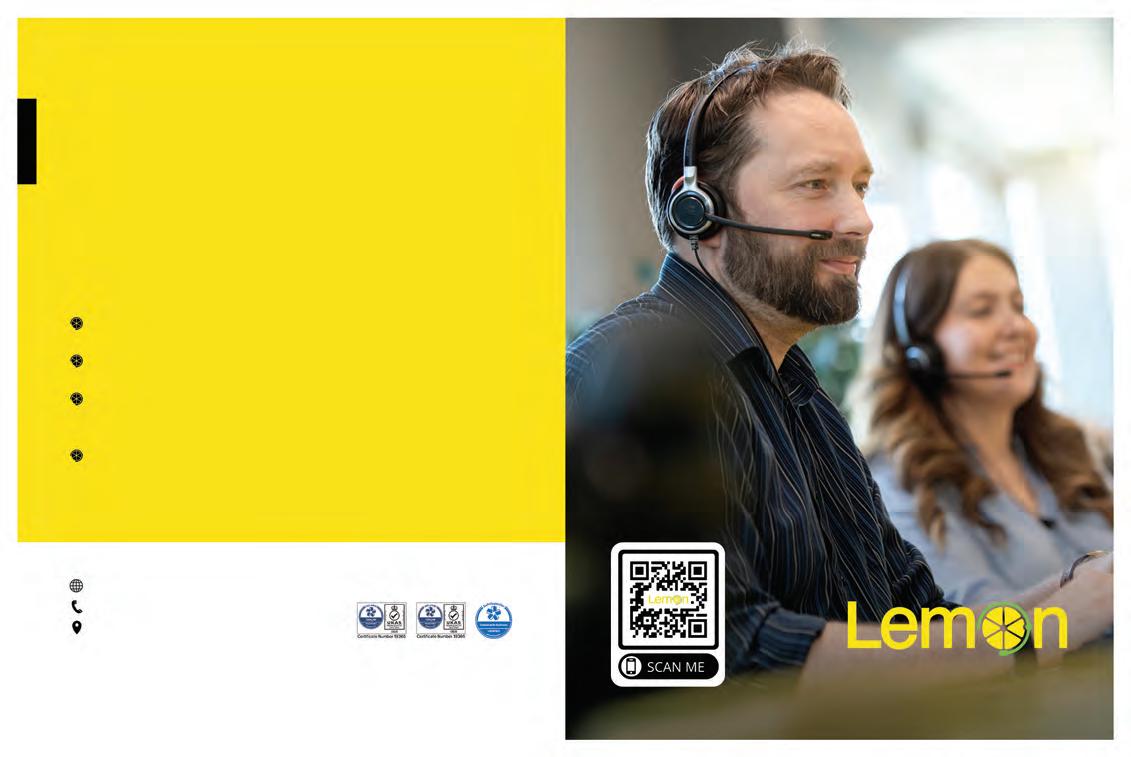

Find us at The Workplace Event 30th April - 2nd May 2024 Birmingham
40-41
THE BEST OF THE SECTOR’S DISCUSSION AND DEBATE
VIEW POINT
Perspectives: Fiona Walters, Bianca Angelico, Michelle Connolly, Toyin Aderiye
Where are we now?
As new compliance protocols are introduced across the built environment, many existing methods of demonstrating compliance, such as Excel data sets, are not good enough.
There are regular updates to sustainability targets, ISO, government and healthcare standards. There have also been issues with materials that have triggered the speedy introduction of new requirements. The RAAC crisis affecting many public sector buildings is a prime example.
Current systems used by many building managers are often not agile enough to adapt to new compliance requirements, which results in panic, and often leads to rushed purchases of new tools and systems to achieve
42
SBFM’s Matt Chapman says we owe frontline workers better development opportunities

compliance without much consideration of improving long-term strategies.
Understanding the data you have, where it is from, and what it is telling you, is so important.
Where do we go next?
To prevent these issues from occurring and, therefore, reducing downtime costs and fines for non-compliance,
A decade ago, it was cheaper to knock everything down and start again
43
Key industry events and IWFM training to further your career development
44-45
John Cameron and Wendy Wallace offer us insights into their jobs
CAFM technology
Managing changes to public sector building compliance requires forecasting systems, retrofitting existing buildings and integrating systems, says Marc Watkins
building and facilities managers need to implement long-term planning for compliance updates. Having the correct processes in place to forecast changes, act on them, and demonstrate compliance without needing to pay out for new software each time will mitigate these issues and future-proof the business.


Being more proactive when considering compliance standards, managers can make sustainable choices. This means changes to data collection or conversion are more efficient and reused where necessary to keep costs down and improve efficiency further.
How do we get there?
Retrofitting existing spaces is the first place to start. A decade ago, it was cheaper to knock everything down and start again, but now the playing field has levelled and implementing older buildings with the right BIM and CAFM technology is more affordable with better results that save money and time.
Integrating these two technologies gives access to better data across every aspect of a building, further improving the FM function. A modular CAFM system allows you to build up your software as your requirements develop. This prevents panic spending on complicated software that you’re only buying for access to one or two functions.
Carrying out initial and follow-up audits to establish that your data is up to date is vital. If these audits reveal that data is out of date or of poor quality, relevant steps can be taken to provide a more solid foundation for reporting and operations.
MARC WATKINS is business development director at Service Works Global
CAFM can be Integrated with software such as SFG20 to ensure the right data is collected and the compliance measures implemented onsite meet current standards. Schedules can be automated but it’s more prudent to use these tools to highlight, suggest and allow for the configuration of your data where and when it is necessary.
NOW > NEXT > HOW
IMAGE: ISTOCK
FACILITATEMAGAZINE.COM 39
WALTERS
SECURE WOMEN

BREAK THE GLASS CEILING
FIONA WALTERS , CEO of G4S UK and Ireland BIANCA ANGELICO
director and chief DayMaker at On Verve
Only around 11% of frontline security officers in the UK are women. However, the security industry is changing: communication, interpersonal skills and diversity are growing in importance and security officers are utilising cuttingedge technology and not relying on physical strength.
The recently launched World Security Report – a survey of 1,775 chief security officers from global companies in 30 countries – found that for the majority of chief security officers, people skills in frontline security professionals are more important than physical attributes of strength.
It is important to have the right people for the job and for security to reflect the demographics of the societies we
work in. Women offer so many of the skills that effective security demands; customer service and engagement skills are now extremely important and there are specific security activities, such as searching and screening, where there is a requirement for women to perform the role.
Women can have a fulfilling career in security, leveraging their skills, but we need to break down the stereotypes around what a security officer looks like and what the job involves.
Guest services businesses are dominated by women, but many don’t have a female leader. Why?
As a business leader, I understand the importance of having the best team around me. I need people I trust, who can help guide me and give me the best advice.
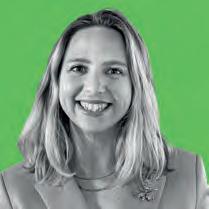
when they return to work?
I don’t know the true answer, but we can look at the facts.
I want to be clear that I don’t believe people are doing things wrong in their business if their leader is a man.
Security officers are utilising cutting-edge technology and not relying on physical strength
At G4S, we have an ongoing drive to increase the percentage of women who not only are joining the industry but who are also getting promoted and pursuing careers. In the UK and Ireland, we are working to retain, develop, and learn from existing women who work across the business. We are also working with customers to provide flexibility to help attract a more diverse workforce.
While there is a long way to go, I am passionate about trying to encourage more women into the security industry. I have benefitted from being able to progress through the business, and I have a responsibility to ensure that other women have that opportunity as well.
On Verve’s board is diverse, with various age groups and professional backgrounds. While the diversity of the board is natural, I recognise the importance of having diversity in my business to promote new ways of thinking and operating while giving underrepresented groups significant professional opportunities.
The guest services world is predominantly women on the front line, but across many brands women are not represented at the C-suite level.
Is it because traditional gender roles still stand?
Is it because women are disadvantaged when taking maternity leave and face more obstacles
But we must acknowledge the trend in this industry. As a business leader, you need to look at your organisation and think about how you can help the disadvantaged groups at your table.
If you observe that there isn’t a lot of diversity at your C-suite level, you need to ask why that is and figure out how you can fix it.
I was told once that I had to wait until I was 40 until I could be a director of any business. Why?
A woman’s capabilities should not be measured by her age, it should be by the experience and expertise she can bring to the table, no matter how many years she has been in the industry.
The glass ceiling still needs to be broken.
I don’t believe people are doing things wrong in their business if their leader is a man
is
BIANCA ANGELICO
FIONA
VIEW POINT / PERSPECTIVES 40 FACILITATE MARCH-APRIL 2024
MICHELLE CONNOLLY
I BLAME POOR COMMUNICATION
CONNOLLY
is co-founder and director a tFM recruiter 300 North
FM companies have a strong focus on recruiting more women into the sector with ambitious workforce gender equality policies. However, there’s still some way to go, and a major factor may be that equity, diversity and inclusion programmes aren’t filtering down from board level. This requires better communication –through the business and beyond, to bring women in from other sectors.
By using targeted recruitment campaigns, companies can engage publicly with a wider audience to whom they can advertise their services, employer brand and value proposition. They can reach talent pools outside of FM, raising awareness of the career paths professionals can enjoy in FM.
Additionally, they can market their benefits programmes, which should be supportive of flexibility, healthy work-life balance, and provide different types of leave to support family life, and include health and financial benefits.
Given that FM is maledominated, women can be fantastic vocal advocates for FM in schools and colleges, encouraging young people into FM career paths. It is crucial to showcase women in leadership roles and communicate
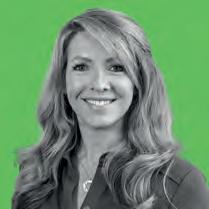
their experience through interviews and case studies.
Gender stereotyping will have played a part in women not seeing themselves in FM careers, so tackling unconscious bias in the recruitment and promotion processes is imperative to achieving gender parity. Businesses can do more to help women navigate perceived barriers of ‘childcare’ and ‘menopause’.
To tackle bias, companies can facilitate mentoring, allowing women to provide education and career guidance to other women. This will enable women in the industry to feel supported and have a peer network they can relate to and communicate with.
Fundamentally, a person’s ability to succeed professionally is unrelated to their gender. It is about their aptitude, insight and skills, and employers providing equitable opportunities for success for all employees.
A person’s ability to succeed professionally is unrelated to their gender
DO IT. PURSUE FM QUALIFICATIONS
The underrepresentation of women in FM, especially in leadership roles, reflects current broader gender disparities across most industries and fields of work.
Despite awareness in FM of standardisation through qualifications, the progression of women through academic qualifications to leadership positions remains sluggish. The push for more standardisation in the industry should be the clarion call for women to move to the forefront of FM leadership by demonstrating an understanding of the field through practical experience, and supporting it with qualifications.
Qualifications can be a great way to demonstrate your understanding on top of your experience.
Traditionally, CVs written by men have stood out more as women tend to overlook the contributions they have made and downplay their impact on the workplace. Men do not shy away from putting forward their contributions, so tend to have stronger CVs.
Qualifications can give the extra edge women need. But men tend to go for qualifications more than women, potentially widening the gulf between


them. At Sheffield Hallam University, there is a threeto-one ratio of men to women studying the Level 7 Extended Diploma in FM. There are too few female leaders at the top of FM organisations despite the proportionately large number of women in the industry. This is not just a loss for women but for the whole industry, which misses out on the unique insights and approaches women bring to the table.
There are too few female leaders at the top of FM organisations
Women should be encouraged to take up qualifications, be given access to female mentors in leadership roles and work in learning organisations. We need increased partnership between educational institutions and industry.
As an industry that recognises experience and qualifications for standardisation, women must not be left behind. They must distinguish themselves for leadership today and in the future.
Visit www.facilitatemagazine.com for more regularly posted opinion columns. Topical, inspirational, angry or amusing – we consider all relevant comment. Get in touch at editorial@facilitatemagazine.com
MICHELLE
DR TOYIN ADERIYE is a lecturer at Sheffield Hallam University
DR TOYIN ADERIYE
PERSPECTIVES / VIEW POINT FACILITATEMAGAZINE.COM 41
IWFM AWARDS 2033 – POSITIVE CLIMATE ACTION: LARGE ORGANISATION (>250 EMPLOYEES)
Johnsons 1871 –highly commended

What we did
The Department for Environment, Food and Rural Affairs’ (Defra) Peterborough operations had to relocate on a tight deadline and required more than 6,000 furniture items – such as large desks or drawer pedestals and items that were more than 35 years old – and other assets from their old buildings to be removed within a three-week window.
Despite Defra’s commitment to sustainability, owing to the type of assets, tight timescales and storage costs, no more than 10% of assets could be reused. The remaining assets would be broken down into component parts and recycled.
Through our Asset 360 model, we reused 45% of these assets, creating £450,000 of cost savings and social value through a combination of an online showroom where visitors could request assets, donations to charities and responsible recycling of
remaining assets that were not donated or beyond repair.
The impact we had
Here’s what we achieved:
● 6,313 assets (about 85 tonne s) were assessed and made available for reuse;
● 44.6% of assets were reus ed;
● 221,198kg of carbon was saved, based on the carbon cost of manufacture;
● £334,520 saved for Defra through ass et reuse versus cost of buying new; and
● 1,647 items worth £139,580 (estimated second-hand value) were donated to external organisations and charities.
What we’ll do next
The successful completion of the Defra Peterborough project is the latest deployment of our Asset 360 solution. Some clients use Asset 360 daily to manage assets, waste and spending – so Asset 360 is definitely not just about clearance. Our aim is to hone the model continuously, making it easier for clients to manage, reuse, repair or responsibly recycle their assets while providing them with the reporting and accountability they require to evidence their Scope 3 impacts.
Rachel Palmer is ESG manager at Johnsons 1871
FORGING STAFF CAREER PATHS
MATT CHAPMAN is CEO of SBFM and an IWFM EDI Focus Group member
Ours is the most diverse industry I’ve experienced. But I ask: why are our frontline colleagues not developing to senior roles at a greater proportion?
I am speaking at an industry event soon and its promotional materials feature an overwhelmingly white audience, which is symbolic of our industry. This is not an insult, merely reality. Too few frontline colleagues get opportunities to develop to become leaders.
Our sector is blessed by diversity. Unfortunately, we don’t always appreciate the value it can bring. Most minority colleagues are perceived as largely invisible and transient; it’s often just accepted, but that should change. Culture is changing and diversity needs to be seen as a benefit and a blessing, rather than a matter of fact.
I used to work at Arsenal Football Club, which is built on diversification and innovation. They promote inclusivity and support disadvantaged groups, which has influenced much of my work. They blaze trails, from establishing training academies in disadvantaged countries to raising the profile of women’s football.
Positive change is generated by all individuals across our sector; the key is

empowering them. There is nothing more rewarding than seeing underrepresented colleagues grow and enhance our sector. If we focus on recognising merit and developing individuals, regardless of their background, change will be far-reaching, positive and powerful.
Our sector is blessed by diversity. Unfortunately, we don’t always appreciate the value it can bring
Organisations should uncover hidden talent and nurture individuals’ goodness, but how is this possible if you don’t know your colleagues?
Learn about employees’ interests and skills –everyone has a story, most have the attitude, but many need support to develop and progress. It’s our responsibility as sector leaders to nurture their potential.
Get in touch at editorial@facilitatemagazine.com or reach us @Facilitate_Mag
VOLUNTEER VIEWPOINT
42 FACILITATE MARCH-APRIL 2024 VIEW POINT / WINNING WAYS
DIARY
Events, activities and publications for your attention
KEY EVENT
SECTOR-WIDE
13-14 MARCH – MANCHESTER
The Manchester Cleaning Show
The major event for the north of England and Scotland spans two days of product sourcing, educational sessions and networking to maximise efficiency. tinyurl.com/Fac23306
25-27 MARCH – LONDON
Hotel, Restaurant & Catering
Join 1500+ suppliers across food and drink, professional kitchen equipment, hospitality technology and design, décor and tableware for the latest trends, talks, tastings and demonstrations. tinyurl.com/Fac24103
10-12 JUNE – LONDON
Euro FM 2024
It's the UK's first time hosting this pan-European event since Glasgow 2015, and first in England since Manchester 2008. This time, London's Metroplitan University is where this unique combination of conference and research symposium is set to take place. tinyurl.com/Fac24017
27 JUNE – BIRMINGHAM
InstallerSHOW
Join 20,000 installers, specifiers and decision-makers working in heat, water, air and energy sectors. tinyurl.com/Fac24014
13-14 NOVEMEBR – LONDON
Build2Perform
Hosted by CIBSE, this event features more than 70 hours of content, 125 speakers and over 100 exhibitors, with government officials, FMs, consultants, and
property experts in attendance. tinyurl.com/Fac24020
2-4 DECEMEBER – LONDON
Anticipate London
Emerging from the fusion of IFSEC, FIREX, Safety & Health Expo, and the Facilities Show, this is the leading event for property and people professionals aiming to thrive in an uncertain future. tinyurl.com/Fac24019
IWFM EVENTS
19 MARCH – ONLINE
Practical Approaches to Water Safety
Responsible for water safety hygiene? The webinar will show you how to get things right at the design stage, the correct components to be used and what you need to monitor and how. tinyurl.com/Fac24018
4 JULY – MANCHESTER
North Region Charity Ball Network with peers while enjoying a champagne reception, threecourse meal, live music, a charity raffle and DJ until 2am. tinyurl.com/Fac24002
IWFM LIVE VIRTUAL TRAINING
25-26 MARCH 2024
Effective property management – 2 days
Understand how to manage and maintain your property portfolio by creating an effective property strategy. tinyurl.com/Fac23503
3-5 APRIL 2024
Effective facilities management professional – 3 days
Are you a junior facilities manager? Find out how to create and sustain effective operations at your organisation. tinyurl.com/Fac24101
NEW 8-9 APRIL
Pathways to Net Zero for facilities managers – 2 days
The IEMA course gives facilities managers a strategic and operational overview of environmental sustainability as it affects their specific industry and work area. tinyurl.com/Fac23401
15-16 APRIL
Managing building services – 2 days
Learn how to reduce risk and improve the management of building services.
tinyurl.com/Fac23511
NEW 29 APRIL
Environmental sustainability skills for facilities workers – 1 day
Increase your environmental and sustainability knowledge across workplace and facilities management teams. tinyurl.com/Fac23402
15-16 MAY
Contract management: commercial models – 2 days
Enhance your commercial skills while learning to maximise value – both financial and functional –from your contracts. tinyurl.com/Fac22020
20 MAY
Building Safety Act: what FMs need to know and do – 1 day Find out essential, practical information to understand and comply with changes brought in by the Building Safety Act 2022 and related legislation. tinyurl.com/Fac23014
NEW 30-31 MAY
Environmental sustainability skills for facilities managers - 2 days Information for facilities managers and supervisors to enhance their
understanding of environmental sustainability and the impact it has on their team and department.
tinyurl.com/Fac23403
17-19 JUNE
Introduction to FM – 3 days
Everything you need to know to embark upon a new career in workplace and facilities management.
tinyurl.com/Fac22028
19-20 JUNE
IOSH managing safely – 2 days
Get up to speed on the practical actions that you need to take to ensure you are prioritising the health and safety of all of your team members.
tinyurl.com/Fac23309
NEW 24-25 JUNE
Pathways to Net Zero for facilities managers – 2 days
The IEMA course gives facilities managers a strategic and operational overview of environmental sustainability as it affects their specific industry and work area.
tinyurl.com/Fac23401
28 JUNE
Building Safety Act: what FMs need to know and do – 1 day
Find out essential, practical information to understand and comply with changes brought in by the Building Safety Act 2022 and related legislation. tinyurl.com/Fac23014
IWFM FACE-TO-FACE TRAINING
22-24 APRIL – LONDON
Introduction to FM – 3 days
Everything you need to know to embark upon a new career in workplace and facilities management.
tinyurl.com/Fac22028
3-4 JUNE – LONDON
FM strategic sourcing: ISO41012 – 2 days
Find out how strategic sourcing can reduce costs, improve quality and deliver better outcomes.
tinyurl.comw/Fac24102
30 APRIL - 2 MAY – LONDON The Workplace Event! Gain insights and discover innovations from sector experts and industry leaders to enhance the employee experience and workplace performance. tinyurl.com/Fac23504 FACILITATEMAGAZINE.COM 43 CALLS TO ACTION / VIEW POINT
What do you do? I am the facilities manager for Eurostampa UK, based in Glasgow but of Italian origin. We produce high-quality labels for the drinks industry.
What attracted you to FM, and how did you get into the industry?
I studied service and maintenance engineering in college and was ‘on the tools’ for 10 years.
I then progressed to the role of facilities assistant and took the natural step to manager when promoted three years ago. I thoroughly enjoy the technical side of FM, so looking after all disciplines was very appealing.
architects and experts from every field. It’s something I’ve never done and has opened my eyes to possible career opportunities.

How long have you been in your current role? Just over a year, I started in January 2023.
Do you see yourself predominantly as a task or a people manager? I would say task management is my forte, but I hope to move into looking after a bigger team in the future. I thoroughly enjoy working with contractors and our in-house engineers to ensure we have full compliance across all PPMs and reactive repairs.
CAMERON
is facilities manager for Eurostampa UK in Glasgow
Would you describe your role as predominantly operational or strategic? It’s certainly more operational. I feel that facilities managers are better suited being on site day to day to ensure we can react to any situations and resolve them as quickly as possible.
How many people are there in your FM team, and to whom does the FM team ultimately report? Facilities forms part of the engineering and facilities team and we are seven-strong just now. We hope to add in the future when we move to our new-build factory.
My top perk at work is… Being involved in the planning and construction of our new factory has been an amazing learning curve spending time with



What has been your biggest career challenge to date? Dealing with a 50,000-litre fuel tank that burst! It was a huge effort that went on for a week to ensure that the area was clean and environmentally stable.
If you could change one thing about the industry, what would it be? I think people’s perception of what facilities management is and the broad range of things we look after and maintain.
Any interesting tales to tell? I used to work out in a remote island called St Kilda and I got a helicopter to work for the week and come back a week later!
If I wasn’t in facilities management, I’d probably be… Doing something with technology or gadgets! I would like to get into visual effects for films etc, but keep putting it off! Maybe this is the year!

Which “FM/Workplace myth” would you most like to put an end to? That what we do is straightforward and it’s just menial tasks. FM comes in so many different forms and is so wide-ranging.
What single piece of advice would you give to a young facilities/ workplace manager starting out? Learn and take in as much as you can every day! If a senior manager gives you a task or something new to learn, embrace it and ask as many questions as possible. You learn that there’s no such thing as a stupid question if it helps you understand the task and improve your knowledge.
What was the weirdest day you’ve had in the office? One day we had a demonstration of how a bird of prey could help our pest control so having a hawk on my arm was not on the agenda that day!



Early bird or night owl? Early bird, for sure. I love being up fresh in the morning and ready for the day.
What FM job in the world would you love more than anything? I think a modern sports facility like a new football stadium or an iconic building such as Big Ben or the BurjKhalifa.
And where would FM be an absolute nightmare? I think in a hot, humid country as I’m not the biggest fan of high temperatures!
Your life outside FM mostly involves… Spending time with my partner, friends and family. I’m from a small Scottish island but live in Glasgow, so I travel home quite often! Also watching any sport I can, I love football, rugby and golf so there’s always something on!
 BEHIND THE JOB
BEHIND THE JOB
John Cameron
44 FACILITATE MARCH-APRIL 2024 VIEW POINT / A BIT ABOUT YOU
JOHN
What do you do? I am a regional FM lead for a large public sector organisation based in Scotland. I cover Highlands and Islands, Grampian and Tayside with around 180 properties.
What attracted you to FM, and how did you get into the industry? I’ve worked in FM for over 30 years in the private and public sector and in different industries. I diversified into public sector procurement for a while, but FM is my passion. I love the diversity and pace, and working with people to solve workplace problems.
How long have you been in your current role? Almost two years.
Do you see yourself predominantly as a task or a people manager? More of a people manager. Communication and collaboration are important as the volume of work involved is immense! It is a challenge as we have people working in remote and rural areas… Thank goodness for MS Teams and satnav!
Would you describe your role as predominantly operational or strategic? Mainly operational, but I’d love to have more time to be laying foundations now for what lies ahead.
How many people are there in your FM team, and to whom does the FM team ultimately report? About 100 in-house team members in my region together with team members employed by our service delivery partner. We report to the national FM lead, then head of estates.
My top perk at work is…
A hybrid and flexible working policy as well as a 35-hour working week. I also work in a nice building with my own office, free parking and a canteen that does amazing curry and chips!
What has been your biggest career challenge to date? The early days and weeks of Covid-19 were scary

up completely unused a few years later and replaced with carpet tiles.
If I wasn’t in facilities management, I’d probably be… I always thought I’d write books, but I clearly don’t have the imagination. I like the idea of working in a small grocery shop in North Spain or maybe being a proofreader (possible to do while sitting in the sun).
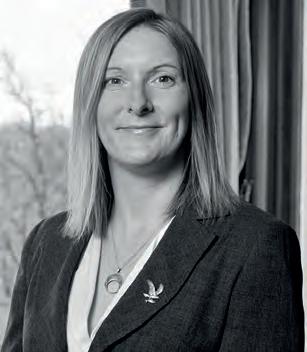




Wendy Wallace
– trying to interpret the changing cleaning requirements prior to lockdown and then interpreting the lockdown rules for building risk assessments, etc. I took on a lot of additional responsibility. It was challenging but probably the most professionally rewarding period of my career.
If you could change one thing about the industry, what would it be? I long for the day when I don’t have to explain what a facilities manager is! I wish it was as understood, respected, and regulated as other professions and that young people saw it as a rewarding career choice. It has vastly improved in the last few years.

Which “FM/Workplace myth” would you most like to put an end to? A bit controversial, but people with trades/ technical or ex-forces backgrounds don’t automatically make good FMs! Curiosity, enthusiasm, interpersonal skills and the ability to work hard and learn are key.
What single piece of advice would you give to a young facilities/ workplace manager starting out? I could probably start my bookwriting career with this question! Think through the consequences of all potential changes before implementing them. You can’t and won’t ever know everything so tap in to the knowledge provided by colleagues, peers and supply chain. Try not to feel pressurised to have all the answers or to come up with fast and cheap solutions – they will come back to haunt you.

What was the weirdest day you’ve had in the office? I once spent a day dressed up as a duck (we were fundraising).
What FM job in the world would you love more than anything? Working in a busy airport or at an exclusive resort in the Caribbean.
Any interesting tales to tell? We once fitted a brand new and expensive carpet in an unused area of a building prior to a member of the royal family visiting. It was ripped
WALLACE
And where would FM be an absolute nightmare? A busy airport! Or a fish factory.
Your life outside FM mostly involves… I run, hill walk and attend gym classes. I’ve climbed a few Munros and completed a marathon and a couple of duathlons (slowly – but got the same medal!). I love travelling and as I had a special birthday this year I visited Berlin, Croatia, Gran Canaria and Mexico!
BEHIND THE JOB
FACILITATEMAGAZINE.COM 45
BIT ABOUT YOU / VIEW POINT
ISTOCK,
IMAGES
WENDY
is a regional facilities management lead within a large public body of the Scottish Government
A
IMAGES:
GETTY


















Discover invaluable knowledge from industry leaders on the future of power Read the 2024 report Pwer Resilience To find out more, call: 0800 088 5315 or download at criticalpowersupplies.co.uk/power-resilience Scan the QR Code
48
KNOW HOW
Caterers at schools have the opportunity to educate kids on healthy eating
Tek screws are the wrong type of fixings to fix ventilation ductwork to dampers. But their use is common, posing significant risks. You need a strategy to check your dampers and schedule remedial work where required.
Correctly installed dampers must be secured by fixings such as aluminium or nylon, which melt in a fire and allow the duct to break away. A collapsing duct could pull the damper out of place and break the seal between the fire zones.
Be under no illusion: incorrectly installed fire dampers may well not perform their function of reducing the spread of smoke in a building during a fire.
Call to action
Make sure you have an up-to-date survey of your fire dampers, and plan remedial works as necessary. Remember this is work that requires multiple skill sets –it cannot just be tagged on to the routine annual inspection and drop testing.
The person who can survey and report on the condition and installation of your fire damper infrastructure is not the same as the technician who will undertake routine inspection, testing and cleaning of dampers. Their proficiency levels and hourly rates are vastly different.
49
Lessons to set FMs on the path to achieving net zero at their organisations
Take the opportunity to scope – and price –the work properly. Any remediation contract will base estimates on an hourly rate, so it’s important the team that your partner fields brings the right combination of skills to the table in the right ratios.
Refit the fixings
If your survey shows that remedial action is required, you will often be able to refit incorrectly fixed dampers using required fusible fixings for a fraction of the cost of replacing a damper from scratch.
53 Leaders need to take responsibility for their people’s pyschologically safety
55
How managers should avoid Friday fails when dealing with team members

Tek screw time bomb
Facilities managers are waking up to a ticking time bomb –the use of steel selfdrilling (Tek) screws to install fire dampers, warns Andrew Steel
Refixing work would be followed by a registered passive fire protection specialist verifying that the correct fire stopping system has been applied and correctly installed. Only then comes the return to routine annual inspection, testing and resetting of the fire damper.
 ANDREW STEEL is managing director at Airmec Essential Services
ANDREW STEEL is managing director at Airmec Essential Services
A damper with the wrong fixing screws could be in good working order and pass annual routine inspection and testing – but if it has the wrong fixings, it may well not perform in a fire.
Work with your service contractor to build a matrix of tasks to be completed, based on the risk attached to the various issues.
Know the rules
The Regulatory Reform (Fire Safety Order) requires the person responsible for the building to take necessary precautions for fire safety in a building.
BS 9999 is the recognised Code of Practice for fire safety in the design, management and use of buildings and it requires fire and smoke dampers to be tested annually. Any dampers found to be faulty must be repaired or replaced on an urgent basis.
BESA DW/145 – Guide to good practice for the installation of fire and smoke dampers and BESA VH001 – Fire damper maintenance, with VH001 3rd edition requires confirmation of the presence of breakaway and flexible joints that will leave the damper in place and maintain fire separation if there is a fire.
There are a lot of people involved in fire damper specification and installation but the Regulatory Reform (Fire Safety Order) requires the person responsible for the building – be that owner or occupying employer – to take precautions for fire safety in a building.
FIRE SAFETY
FACILITATEMAGAZINE.COM 47
THE LATEST LEARNING AND BEST PRACTICE IMAGE: ISTOCK


The caterer’s job goes far beyond providing the lunch menu of the day. School food standards currently provide the minimum benchmark for nutritional standards of school meals for caterers, but value adds are what take education food service to new heights.
Engagement and education about healthy eating at primary school level helps to establish eating habits that are critical to guiding children towards healthier lifestyles in later years.
Healthy eating for young children improves:
● Brain development – children need nutrientrich foods to support their development as well as omega-3 fatty acids found in foods such as fish;
● Learning – a balanced meal with carbohydrates, proteins and healthy fats provides a steady supply of energy during the day; and
● Healthy bodies – healthy eating habits established when young often persist into adulthood, mitigating illness.
Brain food
Catering to children in educational environments is key to healthy eating – but it’s also an opportunity to teach them nutritional skills that add value to their lives, says Charlotte Wright
Explaining these factors to a child under 10 needs to be done in a fun way that appeals to their interests and learning methods.
1 Tell a story
Children connect with stories because the narrative engages their imagination and curiosity. Characters and a plot can teach children moral lessons and help them to develop empathy.
You can encourage healthy eating in schools by explaining the different elements through a story and effectively bypass misunderstandings. Different fruits and vegetables can be characters that go on adventures to solve various problems, for example, with each vegetable or fruit having a specific superpower that translates to how it fuels our bodies.
By using this technique, you can engage children in discussions about healthy eating, deepen their understanding and help them enjoy eating balanced meals.
2 Gamify healthy eating
Turn healthy eating into a game by creating an engaging, entertaining and interactive experience that stimulates children’s curiosity and problem-solving skills to help make better choices. Children learn and explore new ideas through play, so this is a fool-proof method to engage them.
One example could be assigning points to different lunch meal options, so the meals that are the healthiest/ more climate-friendly score the children more points. Then, the children with the most points at the end of the school term get a small prize. This encourages children to choose lunch options that are the healthiest for them, leading to better choices and more engagement with their food.
3 Use mealtimes for socialisation
Teaching children to develop a healthier lifestyle is a key element of catering that can sometimes be overlooked. Socialisation with children at mealtimes is essential to this education, as it helps to create a positive and supportive environment around food. Social interactions during meals also promote mindfulness, enjoyment of food and a sense of belonging, making children more conducive to trying new foods. Making sure your catering team has the right resources to be able to do this well is essential to helping children make healthier choices. Supporting children at the table when they have questions about food or when they are struggling with their meal is the difference between them being open to new things and never wanting to touch a particular type of food again.

We need to teach healthy eating skills to our children early in their lives. As a contract caterer at schools, the children are your clients, not the senior teams or the parents. It is about enriching the lives of our younger generations.
SCHOOL CATERING
48 FACILITATE MARCH-APRIL 2024 KNOW HOW / EXPLAINER IMAGE: ISTOCK
CHARLOTTE WRIGHT is director of C SR & wellness at Elior

In today’s world the facilities manager is continuously having to do more with less. Costs rise, budgets fall. To add to the challenge, as the world demands change and innovation, FM is asked to deliver it.
For many FMs, one of those requests has been to deliver on net zero achievements, which has become an additional task without additional support. When you are in the weeds with no substantive knowledge or clear starting point, it’s a huge ask.
I attended conferences and webinars and sometimes came out more confused than when I went in. The terminology, the amazing claims from suppliers, multiple standards – it’s a bit of a maze. So when the IWFM Academy course, ‘Pathways to Net Zero for Managers’, appeared in my LinkedIn feed, I signed up.
I figured IWFM knows a few things about FM. I wasn’t let down!
The two-day course had varied content and a knowledgeable tutor, leading to great discussions on the challenges we face. My brain and notebook were overflowing, but I left with three key takeaways that have given me greater understanding and will help me deliver both the plan and, in the future, actual net zero for my business.

Learning 1 – standards

It turns out you don’t have to look at reporting against multiple standards or dig through hundreds of pages of information. Some standards are simple, supported and clear on how you get started. They guide you on committing to the process, establishing your net zero targets, and get you on your way to achieving net zero by 2050.

Net zero confident
On top of a whole host of responsibilities, FMs are becoming increasingly integral to organisations’ net zero ambitions, says Helen Kenyon

HELEN KENYON is head of estates at the National Composites Centre



I now know a very simple process to establish a net zero goal for my business. It’s still a lot of work, but the course has provided clarity on what to do and in what order. I can contact the initiative that can help me achieve it.
Learning 2 – lingo
Net zero, carbon neutral, climate neutral, zero carbon, carbon offset, carbon removal – there’s so much interchangeably used terminology although they have different meanings, or are just used to confuse and bamboozle.
The course went through the different terminology, giving definitions and understanding, enabling me to understand the importance of clarifying terminology in communication about sustainability with internal and external customers, but also, to help to spot when a business is possibly trying to ‘greenwash’ its products and services.
Learning 3 –decarbonisation plan
The course sets out what a decarbonisation plan is, how it should be set up, the content, associated emissions reductions and more. There is clarity on short, medium and long-term goals and the evolving nature of this process. It has guided me to set up a full decarbonisation plan for my business, following the hierarchy and allowing for future uncertainty.
By doing this course, I have not become a sustainability expert, and my next steps won’t be quick and easy. I am under-resourced for the work required, I operate in a challenging environment where the type of work changes daily and, like a lot of us, this task won’t be achieved overnight.
Thanks to the ‘Pathways to Net Zero’ course, I now have a clear path for my business. I know how to document and report on our journey to reduce greenhouse gas emissions and how to deliver against our net zero target by 2050 – or sooner.
SUSTAINABILITY
FACILITATEMAGAZINE.COM 49 EXPLAINER / KNOW HOW
IMAGES: GETTY IMAGES, RICHARD GLEED

Unlock career success with IWFM Mentoring: the path to professional growth
IWFM Mentoring is a one-to-one personalised career support service for members in professional grades and those with a complimentary one-year membership as part of their IWFM qualification. You can be a mentor, mentee or both.
The benefits of becoming a mentee
•Receive guidance on advancing your career, achieving your goals and overcoming challenges.
•Gain support in developing your knowledge and skills in line with the IWFM Professional Standards.
•Access impartial advice and an alternative perspective.
•Have a non-judgemental sounding board for your ideas.
The benefits of becoming a mentor
•Pass on your knowledge and experience to help others grow.
•Give something back to the profession by providing support to others.
•Cultivate leadership and communication skills.
To join the IWFM Mentoring programme, visit iwfm.org.uk/mentoring
Professionalising the workforce
Our common framework for workplace and facilities professional development can help your business ATTRACT, DEVELOP, and MAINTAIN your employees. Our products and services are underpinned by the IWFM Professional Standards, developed with industry experts and bespoke to workplace and facilities management. The Standards provide a global competence model for the profession. If you’re
employer looking to develop your teams, please getin touch. Contact us today E @iwfm.org.uk T +44(0)1279 712 650 iwfm.org.uk AFFILIATE TYPICAL JOB TITLE JOB LEVEL Executive Support to Supervisory Manager to Senior Senior to Executive 6 7 2 3 4 5 ASSOCIATE AIWFM IWFM MEMBERSHIP GRADE MIWFM CERTIFIED CIWFM FELLOW FIWFM Facilities Services OperativeFM SupervisorFM Manager Senior/Head (FM Degree)
an





Health and Safety
IOSH Managing Safely R
Training
IOSH Managing Safely Refresher
IOSH Introduction to Risk Assessment
IOSH Asbestos Awarenes R
IOSH Working Safely
Bespoke Courses: Fire Safety, Asbestos Awareness, Risk Assessment

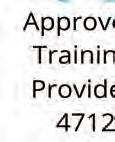



Scan for Info
In PersonLive onLinee-learning



Most people would run away, we’re not most people.
Meet Paul.




Paul crawled underneath patients’ beds in an infectious ward to clear a blocked stack. Without this, the ventilators would have stopped, leaving patients without life-saving equipment.
Drainage, pumps, tankers and plumbing.



Find out more:
www.metrorod.co.uk




Anyone who has worked on a team where they haven’t felt able to speak up and share ideas will know how detrimental it can be in shaping their perception of the opportunity there is to grow and make a meaningful impact as part of that team.

GEORGIA EMMS is an employee engagement and wellbeing consultant
That feeling might have been influenced directly by a manager or by the team’s cultural norms. But it is very hard to reverse once felt.
What is psychological safety?
‘Team psychological safety’, coined by Harvard Business School Professor Amy Edmondson, is a shared belief of members of a team that it is safe to speak up, raise concerns, share ideas and admit mistakes, all without fear of negative consequences.
Psychological safety is fundamental to creating cultures of belonging. It helps
MENTAL WELLBEING
teams build better relationships, encourages diversity of thought, collaboration, and innovation, and increases engagement.
Psychological safety is built over time, with continued and consistent effort but it can be shattered in an instant. Every member of a team plays a role in creating psychological safety, and contributing to culture, but leaders must le ad the charge.
Here are three tips for leaders and managers to influence positive psychological safety in their team.
1 Actively seek out contributions
Don’t assume people will tell you what they are thinking or automatically offer their input. We must explicitly request it. Explain why their voice matters, why their viewpoint and input is important and how it will positively
Why you need to foster psychological safety
Creating a psychologically safe environment for your team is an essential part of being a modern leader, says Georgia Emms
impact the team and the outcomes of the work. So create multiple ways to seek out contributions and surface ideas from your team by asking open-ended questions such as:
● What are your thoughts on this?
● How does this align with what you have worked on previously?
● What are we missing?
2 Admit to your own mistakes
It is important to model the behaviours you want to see in your team. It’s not possible to get everything perfect all the time but, as a leader, if you can demonstrate and talk openly about your mistakes and what you have learned from them, it opens the door for your team to do so too.
Normalise that mistakes are part of the learning process and be open to (and actively seek) feedback from your team.
3 Co-create team norms
Collectively set expectations on:
● How and when team members offer constructive feedback;
● When it’s OK to challenge and when not;
● How you all can encourage healthy conflict; and
● How you will hold each other accountable to a higher standard and call out behaviours that hinder team psychological safety.
Make it clear that active participation in this exercise is required from all team members, and this is not something you as a leader are directing.
Once expectations are set, review these as a team at least once a quarter and when team dynamics change (if, for example, new members join or leave, or if there are changes happening at the organisational level that rock the boat).
There is a lot that influences psychological safety in the workplace. Much of this builds upon standard leadership practices such as active listening, open communication, showing appreciation and support, but it is important to remember that every interaction has the opportunity to either help or hinder that feeling of safety.
As a leader, the biggest priority is to show vulnerability, and to lead the way in cocreating a team environment where each person feels seen, heard and valued.
EXPLAINER / KNOW HOW FACILITATEMAGAZINE.COM 53
IMAGE: ISTOCK, MARIA O’CONNOR
By

Delivery method
Recognised Centres Levels 2-7 or online through IWFM Direct Levels 2,3 and 4
Speak to us today about how to choose the qualification level and size that suits you. Contact us today
E qualifications@iwfm.org.uk
T +44(0)1279 712 651






















































Our insights and research support the development of our profession and drive meaningful change.
Insight hub




•Good practice guides
•Guidance notes
•Research papers
•Policy















•Webinars
•Content hubs


















Want unlimited access? Speak to us about the benefits of being a member. Contact us today
E @iwfm.org.uk
T
completing one of our internationally recognised, regulated qualifications in workplace and facilities management, you can progress on our professional development pathway and build the career you want.
Gain a competitive career advantage We’re driving change
iwfm.org.uk/professional -development
+44(0)1279 712 650 iwfm.org.uk/insight

Avoid these Friday fails
Being somebody’s manager is a huge privilege and comes with power, so be careful what you say – especially on Fridays, warns
Jamie McDonald
With a few words on a Friday afternoon, you can send your team members home walking on air, or crushed and worried. Whether you’re a first-line supervisor or an experienced CEO, your words and actions count.
As an industry, we need to do better at matching leaders’ behavioural skills with their technical abilities. We often promote a highlyskilled technician into a leadership role and hope or assume they’ll naturally know how to communicate, inspire and lead. Many do, but
 JAMIE MCDONALD is customer experience director at VIVO Defence Services
JAMIE MCDONALD is customer experience director at VIVO Defence Services
many don’t. We need a leadership community that meets the needs of FM’s diverse frontline staff. Somebody starting out in leadership recently asked me for tips. I defaulted to the classic but relevant: lead by example, say ‘thank you’, put yourself in their shoes. But it got me thinking about how a junior leader might use that toolkit, and was it practical enough? So here’s my additional advice.
1 Never give difficult feedback on a Friday
It might suit you, but you’ll wreck their weekend. Save the criticism, constructive or otherwise, for Monday. As a leader, you’re paid to carry the issue until you hand it over, so better that you are mildly frustrated over your weekend than them agonising over theirs.
2 Don’t tell people their jobs might be changing/ redundant on Friday
I know it’s the classic day to do it as it protects the operation from a dip in morale/productivity, but
it’s selfish and you’ll send them home full of fear and questions for two days. Do it earlier in the week so they can come to work with questions you can answer before the weekend. If your company’s values are more than just words on the boardroom wall then this is when your ‘we care/people are our key asset’ values can be demonstrated.
3 Be clear about your requests
If you want to catch up with somebody you don’t frequently talk to, and you’re more senior than them, be clear in the email/invite that it’s nothing bad! A managerial request out of the blue can unsettle people. You think you’re empathising and engaging; they may expect the worst.
4 Your seniority matters
If you repeatedly chat and smile with some team members more than others, people notice. You risk the reputation of showing favouritism or being disinterested. If you rarely visit a site, have a meeting and leave, they know you were there but think you chose not to make the effort. Do this often and people remember. Simply greeting people and asking how their day is going can make everybody feel included and special.
5 Don’t give bad news in a bad way
Leaders can’t smile and be positive all the time, but it’s critical to know who is watching and the message you are giving. Giving bad news is part of a manager’s role, but don’t give it in a bad way. You may only have ‘that face on’ for a few hours in the month, but for those engaging with you, it’s their lasting impression. We’re paid to internalise the bad stuff sometimes, so be sure you know who you can safely let off pressure with. If your team is saying to each other that you’re ‘in a right mood today’ then you’ve failed. Being somebody’s boss is a privilege. We need our leaders to use this power wisely.
TIPS
MANAGEMENT
FACILITATEMAGAZINE.COM 55 EXPLAINER / KNOW HOW IMAGE: ISTOCK
Writing winning FM bids has always required a keen strategy, detail, and communication. This will never change, but let’s face it, bid writing is a long, complex, stressful process. So who wouldn’t want help?
Most AI platforms offer benefits that speed up the process of initial drafts compared with human writers. A robust bid library is crucial to creating high-quality responses, however, manually sifting through the library and each document consumes enormous time.
What’s even trickier is attempting to align historical responses with live bid questions. The right AI tool extracts relevant data from various sources to generate new responses, eliminating the need for previous copyand-paste efforts. Time saved creating a blended first draft that’s ready for refinement is a huge advantage.
Remaining relevant
Understanding external factors is as crucial as company knowledge, especially when advancements in equipment, technology and methodologies may mean the ‘cutting-edge’ solution you mentioned in a bid six months ago may no longer be relevant.
If prompted correctly and using the right data sources, AI researches the latest innovations within FM, then integrates them directly into first draft responses without bid writers needing to research manually.
AI creates the first draft, providing bid writers time to refine later versions through reviews and quality assurance. AI shifts the focus to ensuring 80% of writers’ time is
spent on the crucial 20% of the bid, providing consistent quality and, theoretically, more bid wins.
Power of the prompt
When bid writers lack inspiration, generative tech can do it for them, sparking ideas that can be developed further by writers. AI has its limitations but human input can complement it to find a better solution.
Using the same answer bank and similar prompts risks AI
generating repetitive, standard answers, potentially leading to copyright concerns and unengaging responses.
Getting the best results requires correct prompts for AI to create the most relevant, high-quality initial responses. Even when accessing the perfect data sources, poor prompts can lead to poor, generic responses.
Not only is there potential for a standardised output, but the information in the answer bank can become out of date
How AI can help produce FM bids
Artificial intelligence is a powerful tool available to FM teams when bidding on projects, says Phillip Thomson

rapidly – especially in this ever-changing landscape.
To ensure maximum output, a group of AI co-pilots would be trained to expertly prompt FM bid-specific AI. To combat the risk of the answer banks containing out-of-date, irrelevant information, a team of skilled curators can oversee managing the answer bank.
These individuals monitor FM information sources to ensure content – including bid regulations, industry standards, and best practices – is up to date. They will be responsible for deconstructing and archiving previous bids by subject and awarded scores to optimise interrogation of content.
Human touch
 PHILLIP THOMSON is principal bid director at Bidding Ltd
PHILLIP THOMSON is principal bid director at Bidding Ltd
Probably the biggest criticism is that FM bids need a human touch that technology cannot provide. AI produces standard answers that cannot account for commercial acumen, emotional intelligence, sector knowledge, and client-specific messages.
However, the human input from an FM bid professional will generally be the difference between a good bid and great bid. Although the AI co-pilots produce the highest-quality AI-generated content possible, it needs to be refined by humans to deliver a higher-quality final draft, and increase the win probability.
AI streamlines the initial stages of FM bids, but a human-tech hybrid approach is essential for success. Collaboration enhances efficiency, reduces costs, and increases the probability of winning bids in a competitive landscape.
BID WRITING
KNOW HOW / EXPLAINER 56 FACILITATE MARCH-APRIL 2024 IMAGE: ISTOCK

MARK BRAHAM is q uality and assurance director at Mitie and chartered fellow of the Chartered Quality Institute (CQI)
Aristotle said: “Quality is not an act, it is a habit.” This true for FMs who exceed client and organisational expectations while adhering to standards and regulations.
Traditionally, quality has been based on compliance criteria such as legal requirements (for example, electrical and fire alarm testing) and maintaining site cleanliness. Today, quality is about much more. It still encompasses factors such as performance, reliability, safety, efficiency and timeliness, but it can be measured quantitatively and qualitatively.
An FM’s value is clear when their processes align with the organisation’s wider quality ambitions while making their sites places people want to visit.
Companies or individuals tend to have specific perspectives on what quality and standards mean for them, but many hold themselves accountable to formal business management systems; for example, ISO 9001 for quality, and other standards for environment, occupational health and business continuity, audited by an external UKAS-accredited certification body.
Although an organisation’s quality and assurance function will have overall responsibility for meeting these standards, success would not be possible without
Fostering a quality mindset
Client-side FMs must practise three critical habits to ensure FM provision meets their organisation’s quality process ambitions, says Mark Braham
individual FMs embedding quality into their day-to-day activities.
Habits of a quality-focused mindset
1 Use data to drive decisions
Since the pandemic, organisations have shifted in how and how often they use their buildings and infrastructure. Many have ways of collecting data through building management systems and other touchpoints. This data can be analysed to optimise asset management and unlock operational efficiencies. For example, if the
second floor of a building is almost empty each Monday, does it need to open that day?
ISO 9001 requires organisations to make evidence-based decisions, which are most likely to have the desired outcome. FMs also have on-site, first-person perspectives that, when paired with data, can make a compelling case for an organisation to take certain steps to become more efficient or create a better environment. Using data to back up observations means FMs are equipped to have productive conversations with key decision-makers.
2 Always evaluate
Often FMs follow quality management plans that detail each step of the process to meet overarching service level agreements. Yet if they spot inefficiencies or potential risks, frameworks such as Plan, Do, Check, Act (PDCA) can be useful for suggesting solutions. Being not just aware of processes and procedures but thinking critically means FMs can help quality teams improve processes and pre-empt or prevent issues from customers or other employees.
3 Collaborate and connect the dots
Knowledge-sharing is prominent in quality and assurance. ISO 44001 is a standard for establishing and managing collaboration with suppliers, customers, partners and internal departments to generate benefits for all parties, which is often overseen by a dedicated lead, particularly in large organisations.
An FM with oversight of many areas of the business and links to stakeholders can be a key player when working towards this standard.
Even if an organisation isn’t pursuing this standard, FMs can still contribute to a culture of collaboration. Perceptions of quality vary between stakeholders, but an FM’s on-the-ground experience gives them a good sense of what success looks like, adding value for decision-makers at all levels.
FMs can be a key ally to quality and assurance departments. From contributing to meeting external certification standards to improving services, FMs can embed quality at all stages of their role.
QUALITY HABITS
EXPLAINER / KNOW HOW FACILITATEMAGAZINE.COM 57
IMAGE: SHUTTERSTOCK
1

CEILINGS FOR SOUNDS
The selection of ceiling materials plays a pivotal role in achieving optimal acoustics within a space, says Carl Davison, commercial technical manager at Zentia
Key takeaways:
● While Class A products provide the highest sound absorption ratings, this classification may not always guarantee the most suitable acoustic solution for every project;
● Extremely high sound absorption isn’t always the most effective solution – sometimes it can make the wrong environments acoustically flat, making occupants uncomfortable and uneasy; and
● Understanding sound absorption classes and leveraging expertise in acoustic design can enhance the acoustic quality of any space.
3

INTEGRATING DATA
2
The Know How learning continues at facilitatemagazine.com. Here is a summary of the key takeaways from a selection of our onlineonly articles
CHILLING REFRIGERATION COSTS
Refrigeration systems are pivotal in the operations of multiple store formats as they are the biggest energy guzzlers, says Basant Singhatwadia, director of customer innovation and strategy at Facilio
Key takeaways:
● The average supermarket leaks 875 pounds of refrigerant annually, adding up to a whopping 3,432,400 pounds of CO2 eq a year;
● Regular maintenance is required, including cleaning coils

and ensuring proper insulation, ultimately reducing ongoing operational expenditures; and
● The shift from reactive to proactive practices is fuelled by efficient preventive maintenance programmes, automated work order management, and realtime monitoring through IoT.
Every business is digital, with multiple sources of data stored in many different ways and places – so combining it is an essential business task, says Mark Hesketh, head of development at Codiance
Key takeaways
● Customer databases, information stored in applications and real-time data being collected by people are all examples of data that could be integrated;
● There are five core data integration challenges, including a lack of standardisation, legacy systems, limited IT resources, realtime integration, user processes and user behaviours; and
● Make sure you work with an integration partner that visits you on-site, shadows your teams, and understands your processes and the practical day-to-day tasks you carry out. Read the full article at tinyurl.com/Fac24028
full
Fac24026 Read the full article at tinyurl.com/ Fac24027
Read the
article at tinyurl.com/
IMAGES: ISTOCK KNOW HOW / EXPLAINER 58 FACILITATE MARCH-APRIL 2024















14 October 2024 JW Marriott Grosvenor House London ENTER NOW The IWFM Impact Awards are back for 2024 Celebrating excellence and innovation within workplace and facilities management nationally and internationally. The 20 categories available this year are specifically selected by our Judges to help showcase excellence, giving entrants the chance to be rewarded for the incredible work they do at the pinnacle event in the industry each year. Find out more and enter by visiting iwfmawards.org Entry deadline: 10 April 2024 For further information on sponsoring the IWFM Impact Awards email sponsorship@iwfmimpactawards.co.uk or call +44 (0) 20 7880 6206 Headline Sponsor: Supported by: Sponsored by:







The perfect place to find facilities management vacancies. www.iwfmjobs.com is the official job board for The Institute of Workplace and Facilities Management. Find your next role today.
62
SUPPLY SIDE
OCS UK & Ireland plans doubling of revenue in five years
63
Spotless buys up Ashdown Cleaning in pursuit of growth
65
New leaders bolster ABM’s development strategy for 2024
ISS announces ‘solid delivery’ in 2023 financial results
by Facilitate team
International FM provider ISS announced in February that its business momentum was maintained during the last part of 2023, with organic growth of 7.1% in Q4 2023 (Q4 2022: 10.1%) and 9.7% for the full-year 2023 (2022: 8.4%).
This, states the Copenhagen-based group, was primarily driven by price increases and underlying volume growth. Total revenue for the quarter amounted to DKK 20.4 billion (£2.34 billion).
The underlying operating margin improved to 4.6% for the full-year 2023 (2022: 4.0%) and 5.5% in H2 2023 (H2 2022: 4.8%). One-off costs of DKK 233 million (£26.7 million) related to the review of OneISS initiatives were recognised in H2 2023, resulting in a reported operating margin of 4.3% for 2023.
ISS secured a new key account IFS contract with the Danish Government’s Building and Property Agency as well as several smaller and mid-sized IFS key account contracts. At the start of this year, the group extended global contracts including one with Nordea, supporting a client retention rate of 95%.
The group predicts a 4-6% rise in organic growth during 2024. The operating margin is expected to be above 5%. An agreement to divest the French business has been signed and the divestment process is progressing as planned with expected completion in H1 2024.
Kasper Fangel, group CEO of ISS A/S, said: “In 2023, we continued the positive development from previous years, reflected in solid performance, on strategic, operational, and financial levels. We took several steps to enhance the potential of the OneISS strategy, including a review and prioritisation of our strategic initiatives to further build a stronger and value-creating enterprise.
“We also made good progress on our ambition to become the Company of Belonging and reduce our environmental impact. We are in a favourable position, and it gives us the ability to reward shareholders with both an increasing dividend payment and the initiation of a share buyback programme. This has been achieved thanks to the efforts of our more than 350,000 dedicated and passionate placemakers, and I firmly believe that we are well under way in realising the full potential of ISS.”

Find out more Visit facilitatemagazine.com for daily outsourcing news
RECONOMY SETS OUT GUIDE TO NEW RECYCLING RULES IN WALES
Circular economy specialist Reconomy has released a guide to help Welsh businesses prepare for new workplace waste management regulations that come into force on 6 April.
Separated Waste Collections for Workplaces: Reconomy Guide outlines regulations that require all non-domestic premises – such as businesses, charities and public sector bodies – to separate key recyclable materials into at least six recyclable waste streams so that they can be collected and processed sustainably.
There are complementary bans on the disposal of food waste to sewers from non-domestic premises and bans on specified separate recyclable waste streams being disposed of at incineration plants and landfill sites.
The rules form part of the Welsh government’s ‘Beyond Recycling’ strategy, as the nation aims for zero waste by 2050 and to recycle 70% of all waste by 2025. Failure to comply with the measures will be an offence with no upper limit on the courts’ power to fine.
The guide lists specific items that can and can’t be placed into each waste stream and explains how to go about dealing with refuse including food waste and packaging, what waste to put in dry mixed recycling bins, and disposal of waste electrical and electronic equipment, and textiles.
Nathan Gray, Reconomy’s head of sustainability, said: “We look forward to helping businesses make a success of the policy in what could be an exciting acceleration to a more circular economy and zero-waste nation.”
SUSTAINABILITY
FINANCIAL
FACILITATEMAGAZINE.COM 61
OUTSOURCED SERVICE MARKET NEWS AND ANALYSIS
IMAGE: ALAMY
OCS UK & Ireland plans doubling of revenue in five years
by Facilitate team
The service provider OCS has outlined a s strategy comprising “five pillars” to achieve its goals, includng “delivering the best experiences, productivity, practices, resilience, and outcomes for customers, colleagues, and communities”.
Mergers and acquisitions will “further bolster OCS UK & Ireland’s growth, deliver enhanced service quality across all sectors, and improve procurement and compliance processes, leading to integrated, high-quality facility management solutions”.
The plan addresses “the macro challenges in the industries OCS serves, including technology integration, sustainability, environmental compliance, and talent management”. The company stated that “customer priorities are evaluated, and bespoke solutions are developed to tackle complex challenges”.
international facilities service providers”.
This merger expanded OCS’s capacity to offer a broader range of services and expertise, adding value to customers, partners, colleagues, and communities.
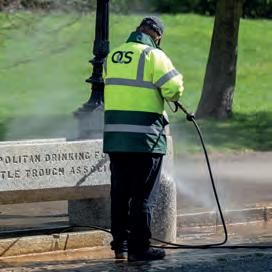
OCS wants to emphasise environmental and social goals that align with “its operations with global initiatives like the United Nations Sustainable Development Goals”. Daniel Dickson, CEO of UK and Ireland at OCS, said: “Launching our new brand and vision is a pivotal moment for OCS… Our role as a provider of critical services across multiple sectors requires us to align perfectly with our customer’s service needs and objectives. Being best-in-class in FM and making people and places the best they can be is about being a trusted partner to our customers, adding measurable outcomes for their operations.’

LINCOLNSHIRE COUNCIL DEVELOPS ‘HYBRID-STYLE’ SERVICES
North East Lincolnshire Council is instigating a new delivery model for a range of services currently provided by Equans across the unitary authority.
Equans and its subcontractors currently carry out several services on behalf of the Grimsby-based council, including highways and transport (and related activities like enforcement, road-crossing patrols), building control, security and facilities management, design services such as architecture, highways design and civil engineering, and the planning service.
The business’s current contract is due to end in June 2025, and the council has had to consider options for future delivery.
The new vision is “a progression from OCS’s merger with Atalian Servest’s UK, Ireland, and Asia operations in March 2023, creating one of the largest
Artic gains
HVAC deal with Hawkins\Brown Hard services provider Artic Building Services has been awarded an HVAC maintenance contract at global
architecture and design firm Hawkins\ Brown’s offices at Clerkenwell, London.
Artic’s team is tasked with overseeing the heating, ventilation, and air conditioning, mechanical, electrical and plumbing, air handling unit, and compliance services.
The original OCS – Office Cleaning Services – was established in 1900. Today’s company comprises a merger of Atalian Servest with OCS and the involvement of American private investment. Another FM service supplier, Incentive FM, was subsumed into the business in 2021.
Sodexo wins
£80m deal at Wellington College Independents by Sodexo has extended its contract with Wellington College’s estate in Berkshire for another 10 years.
The deal, worth £80 million, includes catering, hospitality, retail and domestic
services including cleaning, logistics and laundry at the college. It also involves hospitality and domestic services at Eagle House, the preparatory and prepreparatory school with 360 pupils aged three to 13 in nearby Sandhurst.
The move will see most council services returning in-house, with an aspiration to continue working with existing subcontractors and the local supply chain to deliver public services and support the local economy.
Over the past six months, the local authority has reviewed each service to decide on current and possible future arrangements. Options from the review have been evaluated using HM Treasury’s five-case model.
Wates gains
£21m SHDF retrofit deal Wates has secured a £21 million contract to provide energy improvement works for the Royal Borough of Greenwich in London through the Social Housing Decarbonisation Fund (SHDF) Wave 2.1.
It will carry out retrofitting f 665 homes to upgrade the Energy Performance Certificate (EPC) of selected housing stock in the area to rating C. This aligns with the government’s goal to reach EPC C ratings for all social housing by 2030.
IN BRIEF
GROWTH STRATEGY
SERVICE DELIVERY
SUPPLY SIDE / BUSINESS NEWS 62 FACILITATE MARCH-APRIL 2024
Spotless buys up Ashdown Cleaning in pursuit of growth
by Facilitate team
Spotless Commercial Cleaning has ventured over the border once more to acquire Ashdown Cleaning –adding another 100 staff to its growing UK workforce. The acquisition of Norwichbased office cleaning business for an undisclosed sum expands Edinburghbased Spotless’s revenues, boosting its annual turnover to about £20 million.
Ashdown Cleaning, launched in 2010, has a strong presence in Norfolk and East

Livv retains security deal at One Moorgate Place Boutique workplace experience business Livv, part of ISS, has retained its front-ofhouse and security concierge services contract at One Moorgate Place in the City of London.
The grade II-listed
building – Chartered Accountants’ Hall – is the HQ of the Institute of Chartered Accountants in England & Wales.
Veolia scores sustainability goals at Ashton Gate Veolia has secured a new one-year recycling and waste
Anglia, serving a range of clients in office buildings, business parks, medical and dental practices, manufacturing facilities and retail premises.
The move enables Spotless to build on its foothold in the region, where it already has several commercial cleaning contracts. The deal follows its previous acquisitions in England last January.
Founded in 1988 by its chairman Roger Green, Spotless now operates more than 1,700 contracts across the UK providing a full range of cleaning services for blue chip companies, retail outlets, industrial leaders and premier commercial premises.
Carron Henley, Spotless’s CEO, said: “Ashdown Cleaning has established a strong base and an excellent reputation with its clients across Norfolk and the wider East Anglia area. We’re delighted to welcome their great people to the Spotless team.”
Company chairman Roger Green added: “The office cleaning market is still in flux. Despite this, Spotless continues to go from strength to strength. This latest acquisition significantly enhances our market presence in East Anglia and builds on our growth strategy focused on expanding our presence to cover every UK postcode.”
contract at Ashton Gate Stadium – home of Bristol City FC and the Bristol Bears Rugby Club.
Under the deal, Veolia will manage all waste stream collections for Ashton Gate, Robins High Performance Centre and Bristol Bears High Performance
Centre, creating a proactive service seven days a week, with zero waste going to landfill treatment.
Briggs & Forrester goes up to Oxford Uni Briggs & Forrester Building Services Maintenance has been awarded a
WATES TAKES GPA HUB FIT-OUT DEAL IN CROYDON
Wates
Hubs Programme.
The programme, says the government, will create a network of modern, enabled, shared workspaces for the UK”s civil service workers.
The 330,000-square-foot building, which is planned to accommodate 5,000 civil servants, will offer a selection of flexible and hybrid workspaces fasioned to support neuro-diversity, collaboration and health and wellbeing, along with fully inclusive refreshment hubs, home zones and meeting rooms.
Wates’ assignment to this scheme in Surrey follows a similar fit-out for the GPA which it conducted fir the temporary facility at the Darlington Economic Campus in 2022.
The company’s team will carry out mechanical and electrical engineering, planned preventative maintenance and round-the-clock security services during the works.
This will be the second hub on the four-hectare site, next to East Croydon rail station.
During the project, the business will take part in social value initiatives in Croydon to support young and vulnerable people. It has partnered with a local boxing club, ‘Gloves Not Gunz’, to refurbish the club’s facilities and offer work experience to members.
contract by the University of Oxford to carry out planned and reactive maintenance of combustion plant and associated works.
The deal was awarded to the Northampton-based company following a competitive tender
process. It covers about 150 of the university’s properties across the Oxford, incorporating more than 650 assets which the company will service by applying a hybrid approach of both static and mobile maintenance team application.
ACQUISITION
CONTRACT
Group has been appointed by the Government Property Agency (GPA) to provide a Category B fit-out of 2 Ruskin Square in Croydon for the Government
BUSINESS NEWS / SUPPLY SIDE FACILITATEMAGAZINE.COM 63 IMAGES: ALAMY, ISTOCK










IWFM is the professional body for workplace and facilities management, and we are here to help you prepare for future challenges before they impact you.
Contact us today
E corporate@iwfm.org.uk
T +44 (0)1279 712 675
iwfm.org.uk
Is your organisation facing extraordinary challenges?
are

We are business enablers.


We help organisations understand their FM matu build their FM strategy, and boost their capabilitie o deliver consistently across their operations and liver tangible business value.
e are thought leaders.
develop research, guidance and insight to infor FM profession, shape government policy and slation, and to help organisations stay ahead e game.
are standard setters.
’s Professional Standards define FM competences vels and inform our world-leading professional pment pathway, including qualifications, membership, and CPD.
We are a worldwide community.


IWFM assesses and recognises thousands of members for their competence at each career stage, and together with some of the largest organisations in the world, we collaborate to make change happen.

Let’s work together
ses members petence he o ther uidance, and u invest, ful

With our support, guidance, and insight we can help you invest, recruit, and drive meaningful change in your organisation.



New leaders bolster ABM’s development strategy for 2024
by Facilitate team
Integrated facilities and aviation services company ABM is spearheading its growth plans with the appointment of a new managing director and finance leader.
Campbell Murdoch joins the senior leadership team business as managing director of its Business & Industry division. Led by Richard Sykes, SVP and president for UK and Ireland, Campbell will work with Jim Niblock, managing director for Transport & Aviation, and Ian Anderson, managing director for All Ireland.
Campbell joins ABM from City FM, where he was managing director. He will play a key role in delivering the company’s growth strategy, initally expanding its technical services offering.
vice-president of sales in the UK & Ireland.
Sykes said: “We have entered 2024 with an incredible team in place, ready to deliver on our strategy with efficiency and speed. Contributing industryleading credentials, Campbell and Liz are welcomed additions to the leadership.
“We have many strengths behind us now to push deeper into our chosen sectors including transport, business and industry, public sector, and distribution and manufacturing, and I’m confident that we’ll be seeing significant results in the coming months.”

Liz Freeman also joins the firm as shared services director, Finance, for UK & Ireland. She most recently held a senior senior finance post at OCS.
These appointments follow those in 2023 of Niall Partridge as finance director for UK & Ireland, and Simon Barnes as
Alongside building the leadership team, a part of ABM’s strategy has been to integrate teams under a One ABM approach. Following a move of the London Bridge office into the Transport for London North Greenwich offices, the Blackjack Promotions team in Ireland has also moved into the ABM Ireland HQ.
Most recently, ABM announced the relocation of the two West London offices to a new base at Heathrow, describing the move as “an investment into ABM’s people and the business’ vision for a more aligned culture”.
COMPASS SAYS DURABLE START TO YEAR PROMISES EXPANSION
Food services and FM firm Compass Group has revealed strong growth in trading results for the first quarter ended 31 December.
The group’s organic revenue for the three months to 31 December rose by 11.7%, showing strong growth across all regions. Like-for-like volume was better than anticipated, states the business, especially in the business & industry sectors, adding that all other growth drivers were in line with expectations reported in its full-year results.
The group said that as it focused on the significant structural growth opportunities in core markets, it acquired new businesses and continued to reshape its portfolio.
In January, the business agreed to purchase CH&CO in the UK for an initial enterprise value of about $600 million (circa £473.019 million), with annual revenues of $570 million (c £449,368 million), and to dispose of its small operations in China.
Dominic Blakemore, group CEO, said: “We’ve had a strong start to the year with sustained balanced growth across all regions. Outsourcing trends and volumes were strong despite continued inflationary pressures and some macroeconomic uncertainty.
“Our 2024 guidance remains unchanged. Underlying operating profit growth is expected to be towards 13% delivered through high single-digit organic revenue growth and ongoing margin progression.”
Churchill takes £5.5m deal with ambulance service Churchill has retained its partnership for three more years with the South Central Ambulance Service (SCAS),
covering Berkshire, Buckinghamshire, Oxfordshire and most of Hampshire. It centres on the firm’s Make Ready ambulance preparation services. The deal runsw for three years with an extension option. The alliance began over a decade ago.
JLL to manage
SEGRO’s Slough portfolio JLL’s Property and Asset Management (PAM) business has been appointed by SEGRO to manage its retail and office portfolio in Berkshire under a new threeyear contract.
SEGRO, a UK real
estate investment trust, owner, asset manager and developer of warehousing and industrial property, has expanded its link with JLL to include a 720,000-square-foot portfolio of multi-let office buildings and single-let offices on Bath Road in Slough.
Jaguar wins M&E deals with Landsec
Jaguar Building Services has retained contracts with the Landsec Workplace Portfolio at its Nova site in Victoria in Central London.
The mechanical and electrical maintenance firm
was also awarded six additional building services, fabric, and energy performance deals. The Nova development of 727,000 square feet of offices, retail, leisure and amenity space across three buildings, sits on a 5.5-acre island site near Victoria Station.
IN BRIEF
APPOINTMENTS
FINANCIAL
BUSINESS NEWS / SUPPLY SIDE FACILITATEMAGAZINE.COM 65 IMAGE: ISTOCK
EPH FM ERA


“IF I COULD GIVE YOU ALL ONE PIECE OF ADVICE FOR THIS NEW YEAR IT’S THAT FAILURE IS FEEDBACK, FEEDBACK IS KNOWLEDGE AND KNOWLEDGE IS POWER.”
STEVEN BARTLETT, CREATOR OF THE DIARY OF A CEO , SHARES HIS WISDOM FROM SPEAKING TO MANY SUCCESSFUL GUESTS ON HIS PODCAST



“Something leaders don’t realise about remote work: it’s fair for introverts.”
LINKEDX FOUNDER SAM SZUCHAN REMINDS LEADERS THAT NOT EVERYONE FEELS ENERGISED AROUND OTHERS WHEN WORKING














































“It doesn’t escape workers’ attention that CEO pay rises have been accompanied by job cuts. Good culture is built on trust and trust doesn’t exist without honesty.”



“In my work and research in wellbeing at work over the last 20 years, the repeated calls from employees for an individualised approach to work and wellbeing has been omnipresent; I haven’t seen evidence to suggest that a one-size-fits-all approach has ever served the health and productivity of the working world.”










WORKPLACE CULTURE ENTHUSIAST BRUCE DAISLEY UNDERSCORES THE RELATIONSHIP BETWEEN A HEALTHY COMPANY CULTURE AND BASIC ETHICAL PRINCIPLES












OCCUPATIONAL PSYCHOLOGIST RACHEL LEWIS COMMENTS ON A REPORT ABOUT OMNIEMPLOYMENT, WHICH HENLEY BUSINESS SCHOOL DEFINED AS “THE DIVERGENCE OF THE WORKFORCE FROM A TRADITIONAL ‘ONESIZE-FITS-ALL’ VIEW OF WORK”

“LET’S STOP THINKING ABOUT EMPLOYEES AS EMPLOYEES AND MANAGERS AS MANAGERS, AND START THINKING ABOUT EVERYONE AS PEOPLE. PEOPLE COUNT. THE BUSINESS DOESN’T WORK WITHOUT THE PEOPLE.” WORKPLACE CULTURE EXPERT DAWN SOWERBY SAYS A GREAT WAY OF ALLEVIATING THE PERENNIAL STRESS AT WORK IS TO REMIND OURSELVES THAT WE ARE ALL PEOPLE WITH NEEDS AND LIVES
















“I’M PRO OFFICE IN THE SAME WAY THAT TURKEYS ARE ANTI-CHRISTMAS.” JASON GURD, ASSISTANT DIRECTOR AT GARDINER & THEOBALD, EXPLAINS HOW HE’S TORN OVER HYBRID WORKING AT A RECENT IWFM RISING FMS’ EVENT


“Great culture needs to be lived from the top, everything else is just an empty shell.”
ORGANISATIONAL PSYCHOLOGIST MONA HOLT REMINDS US THAT TALK OF CULTURE IS MEANINGLESS LEST
DAILY REALITY OF SENIOR LEADERSHIP
“HOW RIGID CAN HYBRID WORKING BE BEFORE IT’S NOT HYBRID WORKING ANYMORE? HOW FLEXIBLE CAN EMPLOYERS BE WHILE AVOIDING OVER-FULL OFFICES SOME DAYS AND EMPTY ONES THE OTHERS?”
LEESMAN
“Here we have yet another large-scale study showing that individual level programmes designed to prevent workplace mental ill-health are not effective at achieving their goals. I’ve lost track of how many I’ve shared over the past year or two.”
DR DON MCCREARY, MENTAL HEALTH CONSULTANT, BLAMES BAD WORKPLACES FOR MENTAL WELLBEING INTERVENTIONS FAILING
IMAGES: ISTOCK, SHUTTERSTOCK
CEO
OLDMAN QUESTIONS THE BALANCE
HYBRID APPROACHES TO WORKING AND MANY EMPLOYERS CALLING FOR A RETURN TO THE WORKPLACE
TIM
BETWEEN
66 FACILITATE MARCH-APRIL 2024 BACK PAGE / NOTED AND QUOTED R GISE D AR OUND OTH ERS WOR ENER KING
IT BE THE


The Tork Office Hygiene Package ™ tork.co.uk/officehygiene Take complaints off your to-do list



























 LINDA HAUSMANIS is CEO of the IWFM
LINDA HAUSMANIS is CEO of the IWFM


 WORKER WELLBEING
WORKER WELLBEING






 by Herpreet Kaur Grewal
by Herpreet Kaur Grewal



































































































































































































 BEHIND THE JOB
BEHIND THE JOB


























 ANDREW STEEL is managing director at Airmec Essential Services
ANDREW STEEL is managing director at Airmec Essential Services








































































































 JAMIE MCDONALD is customer experience director at VIVO Defence Services
JAMIE MCDONALD is customer experience director at VIVO Defence Services

 PHILLIP THOMSON is principal bid director at Bidding Ltd
PHILLIP THOMSON is principal bid director at Bidding Ltd





































































































































